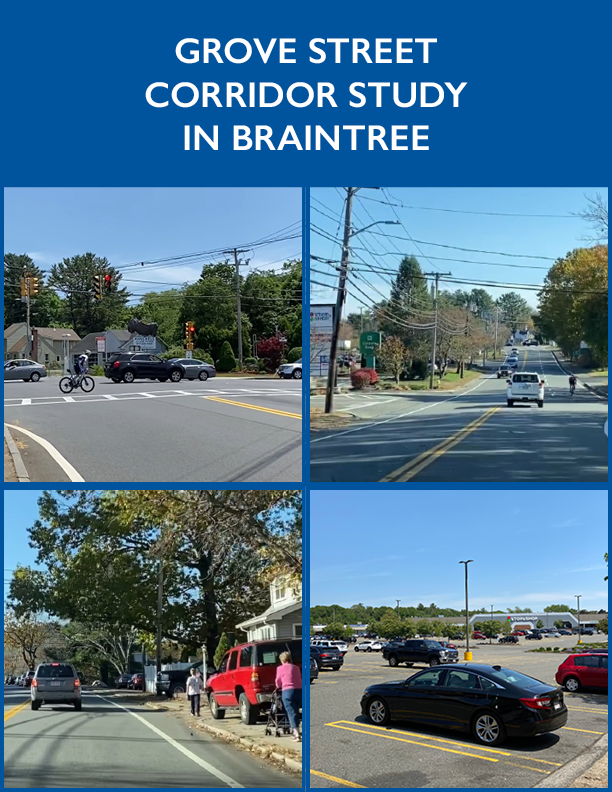

Grove Street Corridor Study in Braintree
Chapter 2 - Existing Conditions and Issues
Chapter 3 - Crash Data Analysis
Chapter 4 - Roadway Operations Analysis
Chapter 5 - Proposed Improvements
Project Manager
Chen-Yuan Wang
Project Principal
Mark Abbott
Data Analysts
Chen-Yuan Wang
Julie Dombroski
Graphics
Kenneth Dumas
Kim DeLauri
Cover Design
Kim DeLauri
The preparation of this document was supported
by the Federal Highway Administration through
MPO Planning Contract #112310.
Central Transportation Planning Staff is
directed by the Boston Region Metropolitan
Planning Organization (MPO). The MPO is composed of
state and regional agencies and authorities, and
local governments.
May 2022
For general inquiries, contact
Central Transportation Planning Staff
State Transportation Building
Ten Park Plaza, Suite 2150
Boston, Massachusetts 02116
857.702.3700
The Boston Region Metropolitan Planning Organization (MPO) operates its programs, services, and activities in compliance with federal nondiscrimination laws including Title VI of the Civil Rights Act of 1964 (Title VI), the Civil Rights Restoration Act of 1987, and related statutes and regulations. Title VI prohibits discrimination in federally assisted programs and requires that no person in the United States of America shall, on the grounds of race, color, or national origin (including limited English proficiency), be excluded from participation in, denied the benefits of, or be otherwise subjected to discrimination under any program or activity that receives federal assistance. Related federal nondiscrimination laws administered by the Federal Highway Administration, Federal Transit Administration, or both, prohibit discrimination on the basis of age, sex, and disability. The Boston Region MPO considers these protected populations in its Title VI Programs, consistent with federal interpretation and administration. In addition, the Boston Region MPO provides meaningful access to its programs, services, and activities to individuals with limited English proficiency, in compliance with U.S. Department of Transportation policy and guidance on federal Executive Order 13166.
The Boston Region MPO also complies with the Massachusetts Public Accommodation Law, M.G.L. c 272 sections 92a, 98, 98a, which prohibits making any distinction, discrimination, or restriction in admission to, or treatment in a place of public accommodation based on race, color, religious creed, national origin, sex, sexual orientation, disability, or ancestry. Likewise, the Boston Region MPO complies with the Governor's Executive Order 526, section 4, which requires that all programs, activities, and services provided, performed, licensed, chartered, funded, regulated, or contracted for by the state shall be conducted without unlawful discrimination based on race, color, age, gender, ethnicity, sexual orientation, gender identity or expression, religion, creed, ancestry, national origin, disability, veteran's status (including Vietnam-era veterans), or background.
A complaint form and additional information can be obtained by contacting the MPO or at http://www.bostonmpo.org/mpo_non_discrimination.
To request this information in a different language or in an accessible format, please contact
Title VI Specialist
Boston Region MPO
10 Park Plaza, Suite 2150
Boston, MA 02116
civilrights@ctps.org
By Telephone:
857.702.3702 (voice)
For people with hearing or speaking difficulties, connect through the state MassRelay service:
For more information, including numbers for Spanish speakers, visit https://www.mass.gov/massrelay
The Grove Street Corridor Study in Braintree is one in a series of studies supported by the Boston Region Metropolitan Planning Organization that address safety, mobility, and access on the Boston region’s roadways. This report identifies specific transportation issues and concerns in the Grove Street Corridor in Braintree, Massachusetts; presents an in-depth analysis of multiple transportation-related factors, such as accommodations for people who walk and bike and safe access to adjacent businesses; proposes short- and long-term improvements to address the problems; and provides a vision for the corridor’s long-term development.
Each year, the Boston Region Metropolitan Planning Organization (MPO) conducts outreach to local agencies, municipalities, the public, and other stakeholders during the development of the Unified Planning Work Program, a program of studies and research projects that provide transportation planning and technical assistance to municipalities and agencies in the Boston region. The purpose of this outreach is to gather information about specific transportation problems in the region so that studies may be conducted to analyze these issues, and projects may be developed to address these issues to improve the operation of the transportation system as a whole.
The MPO’s series of Subregional Priority Roadways studies grew out of this information-gathering process. These studies identify safety, mobility, access, and other transportation-related concerns on specific roadways identified as requiring improvements by subregional planning groups. The studies evaluate potential multimodal solutions to the problems and then make recommendations for agencies and municipalities to implement. Each year, the Boston Region MPO chooses an arterial or collector roadway for staff to analyze, which results in recommendations for short- and long-term improvements for that roadway area.
Selecting a study area in the Boston region is a thorough and exacting process, based on many factors. In any large metropolitan region, there are many roadways that need improvement, so it can be a challenge to single out just one. However, because the MPO’s Subregional Priority Roadways program is ongoing, MPO staff can address each problem area methodically, according to priority and regional needs.
This report focuses on the Grove Street corridor in Braintree, Massachusetts. It contains a review of existing conditions, various safety and operations analyses, and proposed short- and long-term improvements to address the problems in the study corridor.
The study corridor is approximately two miles long, comprising Plain Street, Grove Street, and Columbian Street in Braintree from Hancock Street to the Weymouth town line. Key issues and concerns identified for the corridor include the following:
The recommended short-term improvements would enhance safety for all users and improve traffic operations in the study area. With a high benefit-to-cost ratio, these short-term improvements should be considered and implemented as soon as resources are available. Among the improvements proposed at various locations in the corridor, two projects were recommended for consideration in the short term:
Significantly improving the safety, mobility, and access for all users of the roadway would require a series of long-term improvements. The following major improvements are proposed for the corridor.
The proposed long-term improvements have several expected benefits:
Implementing the recommended long-term improvements in this extensive corridor would require sufficient resources. Four implementation stages can be considered for the entire corridor, as follows:
This report provides a detailed review and recommendations for improvements that address the transportation issues in the Grove Street corridor in Braintree. By addressing these problems systematically through the Subregional Priority Roadways program, the resulting improvements will help to enhance quality of life, support economic development, and improve air quality throughout the MPO region.
During development of the Unified Planning Work Program (UPWP) and the Long-Range Transportation Plan (LRTP), the Boston Region Metropolitan Planning Organization (MPO) gathers feedback from the public, municipalities, the Metropolitan Area Planning Council’s subregional groups, and the Massachusetts Department of Transportation (MassDOT) to identify transportation problems in the region. These problems generally involve accommodations for people who walk and bike, freight movement, traffic bottlenecks, safety of roadway users, and safe or convenient access for abutters along roadway corridors—problems that can adversely affect the region’s quality of life, economic development, and air quality.
Each year, the MPO conducts a study, Addressing Safety, Mobility, and Access on Subregional Priority Roadways, to identify roadway segments in the Boston region that are of concern to stakeholders, but that have not been cited in the regional needs assessment conducted for the LRTP.1 The Subregional Priority Roadways studies focus on arterial or collector roadways and result in recommendations for short- and long-term improvements. Funding for the Grove Street Corridor Study in Braintree was documented in the federal fiscal year (FFY) 2021 UPWP, and a work program outlining the study was endorsed by the MPO board on July 16, 2020.
The Grove Street Corridor Study in Braintree focused on safety, mobility and access, and specific concerns related to bicycle and pedestrian transportation, multiuse trail feasibility, and other subjects raised by stakeholders. The objectives of the study were to
The MPO selected the Grove Street corridor in Braintree by assessing 21 roadway corridors in the Boston region that were identified as potential candidates for study by various sources, including (1) suggestions heard during outreach for the FFY 2021 UPWP; (2) concerns documented in meeting records from the UPWP outreach process since 2012; and (3) data from the MPO’s Congestion Management Process. MPO staff assembled detailed data about these roadways and evaluated them according to the following selection criteria:
The selected roadways belonged to the “Old Route 128” corridor, which runs parallel to Interstate 93 and Route 3 and carries regional and local traffic. The corridor contains various land uses, including a large-scale shopping plaza (Tedeschi Plaza Shopping Center) and several commercial developments, senior living residential developments, multiunit condos and apartments, and single-family residences. In addition, there are ongoing and planned developments in the corridor.
MassDOT Highway Division District 6 recommended this roadway for study to explore Complete Streets needs and safety improvements for all users of the roadway, especially for those who walk. The Town of Braintree noted that residents have expressed their concerns about this corridor because of the high crash rate and crashes caused by high vehicle travel speeds.
The study corridor is about two miles long, comprising Plain Street, Grove Street, and Columbian Street in Braintree from Hancock Street to the Weymouth town line. It is a two-lane roadway classified as an Urban Minor Arterial and is under the jurisdiction of MassDOT District 6. The study area covers the corridor and its adjacent areas and connected roadways. Major cross streets in the corridor include John Mahar Highway, Plain Street, and Liberty Street. Figure 1 shows the study corridor, adjacent roadways, and major developments in the study area.
At the request of MPO staff, MassDOT collected daily traffic volumes and intersection turning movement counts (including pedestrian and bicycle movements and the percentage of heavy vehicles) for this study from April 7 to April 13, 2020, a period during the COVID-19 pandemic when traffic was still less intensive than the usual conditions. Staff reviewed historical counts and MassDOT COVID-19 traffic monitoring reports and made a series of adjustments to the collected data, so that the data would reflect the normal traffic conditions that are used in a series of essential analyses in this study.
MPO staff also collected a series of data from the Town of Braintree, including land use and zoning information, traffic studies from recent proposed developments and redevelopments in the corridor, and the police crash reports for a five-year period from 2015 to 2019.
MPO staff developed a corridor user survey to gather feedback from the public on perceived and actual problems with the corridor and to solicit improvement ideas. The survey yielded helpful information in identifying the issues and concerns and in developing improvement strategies for the corridor.
During the study, MPO staff worked closely with an advisory committee comprised of representatives from the Town of Braintree, MassDOT Office of Transportation Planning, and MassDOT Highway Division District 6. (See Appendix A for a complete list of the study advisory members.)
Two advisory committee meetings were held to guide and support the study. In the first meeting (February 11, 2021), MPO staff introduced the study, received input about the corridor’s issues and concerns, and coordinated data collection needs. In the second meeting (December 10, 2021), staff presented the analyses and findings and discussed the proposed short- and long-term improvement alternatives with the advisory committee members. After the meetings, staff received comments and revised the proposed improvements accordingly.
The study corridor is about two miles long, comprising Plain Street, Grove Street, and Columbian Street in Braintree from Hancock Street to the Weymouth town line (Figure 1). It is a two-lane roadway, one lane in each direction, which carries approximately 14,000 to 19,000 vehicles per weekday. The entire corridor is classified as Urban Minor Arterial and is under the jurisdiction of MassDOT Highway Division District 6.
The corridor contains three signalized intersections, three uncontrolled marked crosswalks, several unsignalized intersections and commercial driveways. The three signalized intersections are Plain Street at John Mahar Highway, Grove Street at Liberty Street, and Grove Street at Columbian Street. The three marked crosswalks are all located on Grove Street, one just south of Hannah Niles Way, one near Heritage United Methodist Church, and one just north of O’Toole Terrace.
The adjacent land uses in the corridor include residential, commercial, religious, and open lands. The majority of the adjacent areas are under residential zoning, which contains mainly single-family houses and some multiunit residential developments. In addition, there are two major commercial areas: a general business district located on Grove Street near Liberty Street and a highway business district located on Columbian Street south of Grove Street.
The corridor can be roughly distinguished into four sections based on adjacent land uses and the existing roadway layouts. The first section, Plain Street between Hancock Street and Grove Street, contains mainly residential and some commercial areas. The roadway’s adjacent areas are fully developed with single-family houses. It has two 12-foot travel lanes, with relatively wide shoulders (four- to six-feet) and sidewalks on both sides.
The second section of the corridor, Grove Street between Plain Street and Liberty Street, contains residential areas, a senior living community (Grove Manor Estates), a church (Heritage United Methodist Church), and a major business district that houses Tedeschi Plaza Shopping Center. The travel lanes in this section are wider than the previous section. It lacks sidewalks on the northbound side.
The third section, Grove Street between Liberty Street and Columbian Street, contains mostly residential areas, with some open spaces located near Columbian Street. The travel lanes in this section are wide and with shoulders of inconsistent widths. It lacks sidewalks on the southbound side.
The last section, Columbian Street between Grove Street and the Weymouth town line, contains a major business park at 60 Columbian Street and a number of businesses with their own driveways and on-site parking. No sidewalks exist on either side and shoulders are generally narrow with a width of about three feet.
There are no dedicated bike lanes in the entire corridor. Shoulders are generally narrow (about two- to three-feet wide), except in some limited and discontinuous sections. Meanwhile, most sections in the corridor have a posted speed limit of 40 miles per hour (mph) and vehicles generally travel at a speed much higher than the posted speed limit.
There are no Massachusetts Bay Transportation Authority (MBTA) or local transit services in the corridor. However, there are a few regional and subregional transit services in the areas adjacent to the corridor (see Figure 2). These include a station for two MBTA commuter rail lines, Kingston/Plymouth Line and Middleborough/Lakeville Line, with stops at Braintree Station. It is a major station with a parking garage of more than 1,200 spaces that also connects the MBTA rapid transit Red Line and a number of MBTA bus routes.
Meanwhile, three MBTA bus routes, 226, 230, and 236 serve the adjacent areas. Route 226 runs between Braintree Station and Weymouth Square; Route 230 runs between Montello Station in Brockton and Quincy Center Station (via Hancock Street in Braintree); and Route 236 runs between South Shore Plaza in Braintree and Quincy Center Station.
This corridor is less than one mile from Braintree Station and is a key route for commuters from the South Shore area to access the station for Boston Downtown or other major destinations.
Boston Region Metropolitan Planning Organization (MPO) staff prepared and conducted a survey to help determine the public’s opinion about the issues and problems on the study corridor, and to gather ideas for resolving them. The online survey was posted on the Boston Region MPO website and published in Metropolitan Area Planning Council newsletters and social media channels and received 155 responses between March 16 and May 4, 2021.
The survey contained the following nine questions:
Multiple choice answers are allowed in Questions 1 to 7 and a single answer applies to Question 8, while Question 9 required a written response. Figure 3 shows the results from the first seven questions of the survey, with the number of respondents and the percentage of applicable answers to each question being summarized in horizontal bar charts. In addition, the number and percentage of each answer and comments in answering “other (please specify)” for Questions 1 to 8 and written comments for Question 9 are summarized in Appendix B.
Question 8 is designed to understand the geographical distribution of the respondents. The answers indicate that about 93 percent of the respondents live in Braintree and more than 60 percent of them reside within one mile of the corridor. The rest of the respondents are mostly South Shore residents: six from Weymouth, one from Hingham, one from Milton, one from Norwell, one from Scituate, and one from Randolph.
Question 9 is a free response question for the respondents to describe further viewpoints and to cover the problems and improvement ideas that the survey answers might not have included. Nearly half of the respondents left significant feedback for the question. Their comments are listed with no alterations in Appendix B.
The following list includes notable conclusions drawn from the survey.
Feedback from the survey was helpful to gauge community sentiment and to solicit ideas for solutions to the existing problems. Some of the ideas were considered in developing the improvement alternatives discussed in Chapter 5. MPO staff also received additional comments on the corridor’s issues and concerns. These comments are included in Appendix C.
Based on findings from the user survey, analyses of crash data and existing traffic operations, and discussions with the study advisory members, major issues and concerns of the corridor include the following:
These issues and concerns are about the corridor in general. The issues and concerns at specific locations in the corridor are further analyzed and identified in Chapters 3 and 4 and are summarized by location along with the proposed improvements in Chapter 5.
Crash data are an essential resource for identifying safety and operational problems in a study area. Analyzing data on the number of crashes and types of collisions that occur at particular locations, and the circumstances under which crashes occur (such as the time of day and roadway surface conditions) also helps to develop improvement strategies.
For this study, Metropolitan Planning Organization (MPO) staff collected the most recent five-year (2015–19) crash reports from Massachusetts Department of Transportation (MassDOT) Crash Data Portal (https://apps.impact.dot.state.ma.us/cdp/home) for the entire corridor and conducted a series of crash data analyses.
In total, 176 crashes were recorded in the five-year period at different locations in the corridor. Major statistics analyzed from the data set including the following (see Appendix C for the crash data summarized by year):
Based on the five-year crash data and the estimated average daily traffic, MPO staff estimated that the entire corridor has a crash rate of 3.17 crashes per million vehicle-miles traveled (MVMT). This crash rate is close to the statewide average for minor urban arterials, which is 3.49 crashes per MVMT (updated July 2020, based on 2017 crash data).
Staff further calculated the crash rates by five consecutive segments in the corridor based on the comparable land use characteristics and daily traffic volumes. The crash rates for the five segments include
Note that the segment of Grove Street has a very high crash rate due to intensive activities at the shopping plaza and most of the crashes in the Columbian Street segment were in the vicinity of the intersection at Grove Street. Appendix D contains worksheets showing the crash rate calculations for the entire corridor and the five different segments in the corridor.
Staff also calculated the crash rates at major intersections in the corridor, based on the yearly average of MassDOT crash data and the estimated intersection traffic counts. The crash rates for the signalized intersections are as follows:
The average crash rate for MassDOT District 6 signalized intersections is 0.71 crashes per MEV (updated June 2018, based on 2016 crash data). None of the intersections have a crash rate higher than the district average. The crash rate at the intersection of Grove Street at Columbian Street is considered to be comparable to the district average.
Among the unsignalized intersections, Plain Street at the driveway of the Registry of Motor Vehicles (RMV) is estimated to have the highest crash rate of 0.53 crashes per MEV. The rate is slightly higher than the average crash rate for unsignalized intersections in MassDOT District 6, which is 0.52 crashes per MEV.
Appendix E contains worksheets showing the crash rate calculations for all the signalized and unsignalized intersections in the corridor.
To investigate safety and operational problems further, MPO staff constructed collision diagrams for the entire corridor at major intersections and in the roadway segments between those intersections, based on the recent five-year crash data. Appendix F presents eight collision diagrams for eight consecutive sections in the corridor. It also includes information on the crashes in each section (indexed by chronological order of occurrence) summarized in a lookup table following each collision diagram. The information includes crash date and time, severity (property damage only, nonfatal injury, fatality, or unknown), manner of collision type (rear-end, angle, single vehicle, rear-to-rear, sideswipe [same or opposite direction], head-on, or unknown), road surface conditions, weather conditions, most harmful event, vehicle actions prior to crash, and driver contributing code.
Key findings from collision diagram analysis and factors that might have affected safety and operations at major intersections and roadway segments in the corridor are summarized below.
The findings from collision diagrams are useful for identifying safety and operational problems and developing improvement alternatives at major intersections and specific roadway segments in the corridor. The findings are further discussed in the context of proposed improvements in Chapter 5.
To analyze the existing roadway operations, Metropolitan Planning Organization (MPO) staff requested Massachusetts Department of Transportation’s (MassDOT) assistance in collecting automatic traffic recorder (ATR) counts on the approaching roadways and intersection turning movement counts (TMC) for this study. The ATR counts include daily traffic volumes and spot speed counts and the TMCs include pedestrian and bicycle counts at the intersections.
The data collection was performed from April 7 to April 13, 2021, a period that traffic started to increase from the spring in 2020 when the COVID-19 pandemic was prevalent.6 However, the traffic had not reached the pre-pandemic level, according to MassDOT COVID-19 traffic monitoring reports.7
Staff reviewed historical counts and MassDOT COVID-19 traffic monitoring reports for major roadways in District 6 and made a series of adjustments to the collected data, so that the data being used in these operational analyses would reflect the normal pre-pandemic traffic conditions.
Daily traffic volumes are the fundamental data for analyzing traffic intensity and patterns in a roadway corridor. Staff used the ATR counts collected on weekdays from April 7 to April 13 as the basis to estimate the annual average weekday traffic volumes at key locations in the corridor (see Appendix G for the originally recorded counts by hour).
Staff estimated the annual average weekday daily traffic (AAWDT) in two steps: (1) applying axle adjustment (one percent reduction) and seasonal adjustment (eight percent reduction) factors to the recorded volumes, and (2) increasing the factored volumes by seven and one-half percent to represent the normal traffic conditions based on the analysis of MassDOT traffic monitoring reports.
Figure 4 shows the estimated 2021 average weekday traffic volumes. The numbers in the graphic are average weekday directional AAWDT volumes representing the normal traffic conditions in 2021. The two tables in the graphic further summarize the data by count location, originally recorded volume, estimated AAWDT from the recorded volumes, and the final adjusted AAWDT by directions and in combination.
In general, the corridor carries an average daily traffic volume of about 14,000 to nearly 19,000 vehicles per weekday. The Grove Street sections adjacent to Tedeschi Plaza Shopping Center carry the highest daily traffic ranging from 16,000 to nearly 19,000 vehicles per weekday. The section of Plain Street west of John Mahar Highway carries the least daily traffic of about 14,000 vehicles per weekday. The Columbian Street section carries about 16,500 vehicles per weekday.
In addition to daily traffic counts, MassDOT collected TMCs at major intersections in the study corridor, including vehicle movements (by vehicle classifications), bicycle movements, and pedestrian crossings. These counts were collected during the morning peak period (6:00 AM–10:00 AM) and the evening peak period (2:00 PM–6:00 PM) on Thursday, April 8, 2021, and during the midday peak period (10:00 AM–2:00 PM) on Saturday, April 10, 2021. Appendix H contains these counts summarized by hourly and 15-minute intervals.
Figure 5 shows the weekday AM and PM peak hour TMCs at major intersections in the corridor, based on the TMCs recorded on April 4. The intersection of Grove Street at Liberty Street carried about 2,100 vehicles in the AM peak hour and nearly 2,700 vehicles in the PM peak hour. The intersection of Grove Street at Columbian Street carried about 1,650 vehicles in the AM peak hour and about 2,300 vehicles in the PM peak hour. The intersection of Plain Street at John Mahar Highway carried about 1,200 vehicles in the AM peak hour and about 1,800 vehicles in the PM peak hour.
Staff found that the volumes in these counts are generally lower than those collected in recent years before the pandemic by comparing them with historical counts at major intersections in the corridor.8 The analysis observed the following traffic volume and pattern changes:
Based on this analysis, staff increased the recorded turning movements at the count locations by 25 to 30 percent in AM peak hour and by eight to 10 percent in the PM peak hour to represent normal pre-pandemic traffic conditions, except the intersection of Grove Street at Liberty Street. Staff used the peak hour TMCs at the intersection directly from a recent transportation study for the redevelopment of 60 Columbian Street (see Appendix I for the original counts collected on Thursday, March 21, 2019).10 Using the counts at this key intersection as the basis, staff made additional adjustments to the counts at other intersections through a count-balancing process.
Figure 6 shows the final adjusted weekday AM and PM peak hour TMCs at major intersections in the corridor. The counts indicate that under normal traffic conditions on an average weekday, the intersection of Grove Street at Liberty Street could carry nearly 2,700 vehicles in the AM peak hour and about 3,000 vehicles in the PM peak hour. The intersection of Grove Street at Columbian Street could carry about 2,000 vehicles in the AM peak hour and nearly 2,600 vehicles in the PM peak hour. The intersection of Plain Street at John Mahar Highway could carry about 1,650 vehicles in the AM peak hour and nearly 2,000 vehicles in the PM peak hour. The other intersections in the corridor would carry a traffic volume of about 1,350 to 1,550 vehicles per AM peak hour and about 1,500 to 1,900 vehicles per PM peak hour.
The counts also indicate that the intersection of Grove Street at Liberty has a high proportion of left turns on the Grove Street northbound approach and on both approaches of Liberty Street (especially on the northbound), and a high proportion of right turns on the Liberty Street northbound approach. The intersection of Grove Street at Columbian Street has a high proportion of left turns on the southbound approach (Grove Street) and a high proportion of right turns on the northbound approach (Columbian Street). The intersection of Plain Street at John Mahar Highway has a high proportion of left turns on the southbound approach (John Mahar Highway) and a high proportion of right turns on the westbound approach (Plain Street).
The TMCs that MassDOT collected for this study also include Saturday, April 10, 2021, midday peak-period and peak-hour counts. Analysis of the Saturday peak-hour counts indicates that the traffic movement patterns in the Saturday peak hour are similar to that in the PM peak hour at major intersections in the corridor, and the Saturday peak-hour traffic volumes generally are about five to 10 percent lower than those in the PM peak hour.
In addition to traffic volumes, the intersection TMCs—conducted in the extended four-hour peak periods in the weekday morning and evening and on Saturday midday—also provided pedestrian crossing counts and bicycle counts by turning movements on each approach for this study.
The pedestrian crossing counts in the AM and PM peak hours at major intersections in the corridor are shown in Figure 5 and Figure 6.11 On the count date, the intersection of Grove Street at Liberty Street had about three to five pedestrian crossings per peak hour. The corridor sections adjacent to Tedeschi Plaza Shopping Center also carried noticeable pedestrian activities. The intersection of Grove Street at the plaza’s middle driveway and Hemlock Street had about five to six pedestrian crossings per peak hour. The crosswalk at the heritage United Church had about one to two pedestrians crossing Grove Street per peak hour. The counts also indicate that there were about five pedestrians walking along Grove Street between Plain Street and Liberty Street in the AM or PM peak hour.
The counts in other hours of the AM or PM peak period (total four hours in each period) generally observed a similar or a smaller number of pedestrian crossings at the various intersections in the corridor.
Review of the bicycle counts at the major intersections indicate that about one to three cyclists traveled along the corridor during the weekday AM or PM peak period. On a fair-weather Saturday (April10, 2021), there were about two to five cyclists traveling in the corridor from 10:00 AM to 2:00 PM.
There are no sidewalks on the east side of Grove Street north of Liberty Street, no sidewalks on the west side of Grove Street south of Grove Street. Most sections of the corridor have no bicycle accommodations in the entire corridor and limited crosswalks across Grove Street. These may have discouraged walking and biking activities in the corridor. In addition, the counts were performed in early April when the weather was still relatively cold and there could have been more people walking and more biking activities in other warmer months of the year.
It is essential to examine the amount of truck and bus traffic in a study corridor, as an unusually high percentage of these heavy vehicles may seriously impact roadway operations.12
Staff reviewed vehicle classifications in the TMCs and identified the percentages of heavy vehicles within the total traffic at major locations in the corridor. On average, heavy vehicles accounted for approximately three to five percent of the corridor traffic in the AM peak hour, and approximately one to two percent in the PM and Saturday peak hours. These percentages are regarded as normal for an urban minor arterial.
The percentage of heavy vehicle traffic by direction of approach to the major intersections was calculated in the intersection capacity analyses and the traffic simulation models used for this study. The capacity analyses detailed in the following sections indicate that the existing volumes of heavy vehicles do not seriously affect traffic operations at the intersections studied.
Based on the observed and estimated TMCs, MPO staff constructed peak-hour traffic models for the entire corridor and conducted capacity analyses for major intersections using Synchro, a traffic analysis and simulation program.13 The model set consisted of weekday AM and PM peak hour models and scenarios, including signal retiming under the assumed existing conditions and proposed improvement alternatives under the projected future traffic conditions in 2030.
Figure 7 shows the results of weekday AM and PM peak-hour capacity analyses for the observed 2021 traffic conditions at major intersections in the corridor and the level of service (LOS) each intersection provides.
The LOS was determined based on criteria from the Highway Capacity Manual (HCM).14 The HCM defines LOS, using a qualitative scale from A to F, for signalized and unsignalized intersections as a function of the average vehicle control delay.15 For the intersections in a metropolitan urban area, LOS A, B, and C are considered desirable; LOS D and E are considered acceptable; and LOS F is considered undesirable.
Based on the observed counts on April 8, 2021, the intersection capacity analyses indicate that major intersections in the corridor generally operated at acceptable LOS in the AM or PM peak hour. This primarily resulted from the traffic reduction during the pandemic (see the analysis in Section 3.2).
Figure 8 shows the results of weekday AM and PM peak-hour capacity analyses at major intersections in the corridor for the estimated 2021 normal (non-pandemic) traffic conditions. Based on the estimated 2021 traffic volumes (Figure 6), the intersection capacity analyses indicate that the signalized intersection of Grove Street at Liberty Street would operate at an undesirable LOS F, with average delay of more than one and one-half minutes per vehicle in the AM peak hour. Though it would operate at acceptable overall LOS D in the PM peak hour, all the approaches, except the Grove Street southbound, would operate with an average delay of approximately one minute or more.
At the signalized intersection of Grove Street at Columbian Street, the westbound approach (Grove Street) would operate at LOS E with an average delay of approximately one minute in the AM peak hour and at LOS F with an average delay of nearly one and one-half minutes in the PM peak hour.
For the unsignalized intersections, all the stop-controlled approaches would operate at acceptable LOS, except the middle driveway from Tedeschi Plaza Shopping Center to Grove Street. The through and left-turn shared approach on the driveway would operate at an undesirable LOS F with average delay of two minutes or more per vehicle during the AM and PM peak hours when the Grove Street traffic is busy.
Staff also explored opportunities of retiming signals at the three signalized intersections and found that all have the potential to improve from the existing timing settings. These options are discussed in Chapter 5. Details of Synchro capacity analysis reports for the major intersections in the weekday AM and PM peak hour under the 2021 observed and estimated traffic conditions are included in Appendices J and K.
One of the major concerns raised by the town residents is the generally high travel speeds in the corridor. In order to examine the prevailing travel speeds versus regulated speeds, MPO staff requested that MassDOT help collect spot-speed data during the period when automatic traffic counts were being conducted.
Figure 9 shows the existing speed regulations and estimated 85th percentile speed at selected locations in the corridor, based on spot-speed counts collected from automatic traffic recorders. The 85th percentile speed is the speed at or below which 85 percent of vehicles passing a given point are traveling, and it is the principal value used to establish speed controls by MassDOT. It is generally regarded as the prevailing speed at a location where the speed data is collected.
The corridor has three speed regulations:
The regulated speed limit in each zone applies to both directions of the roadways in corridor. The 85th percentile speeds estimated from the data indicate that vehicles generally traveled about three to five mph higher than the regulated speeds, except the Grove Street northbound section between Tedeschi Plaza Shopping Center and Heritage Methodist Church. The prevailing speed there is almost 10 mph higher than the 35-mph regulated speed. It is concerning that drivers tend to speed up after they pass the busy commercial section and may not pay attention to the upcoming crosswalk near the church.
The proposed long-term improvements described in this report with the reduction of travel lane width and the addition of separated bicycle lanes would potentially reduce travel speeds in the corridor. At the design stage, a consistent 35 mph speed limit could be considered for the entire corridor, except the 30-mph speed zone near Plain Street. It should be maintained with the same regulation, due to its curvature and limited sight distances. In the near term, if the speed regulation in the aforementioned section is to be changed, an engineering study, based on speed data collected from radar or laser guns, would have to be undertaken.16
The corridor is a two-lane roadway and generally has a right-of-way width of about 60 feet. Based on the existing street layouts and adjacent land uses, the corridor can be distinguished into four roadway sections:
Figures 10 to 13 show the existing roadway cross section and potential reconfiguration alternatives in the four roadway sections. In each of the roadway sections, the cross section represents a typical layout in or near the tightest right-of-way area. It exhibits the view of a southbound driver in the corridor.
The top graphic in Figure 10 shows that the existing roadway contains a 12-foot-wide travel lane, an eight-foot shoulder, and a six-foot sidewalk in each direction. Field observations indicate that one to two vehicles could occasionally occupy the relatively wide shoulders. As the adjacent areas are fully built, with continuous sidewalks on both sides, two potential reconfigurations are proposed within the existing street layout: (1) to reduce the travel lane to 11.5-foot and install a street-level bike lane (five feet wide) with a traffic buffer (three and half feet wide) in each direction; and (2) to reduce the travel lane to 11.5-foot and install a raised bike (six feet wide) with a roadway shoulder of two and half feet wide (see the middle and bottom graphics of Figure 10).
The section contains mainly residential land uses (single-family houses and apartments), a senior living community (Grove Manor Estates), a church, and a major business district (Tedeschi Plaza Shopping Center). The top graphic in Figure 11 shows the existing roadway layout near the shopping center. It contains a 12.5-foot-wide travel lane and a six-foot shoulder in each direction. Sidewalks (five to six feet wide) exist only on the southbound side and utility poles exist mainly on the northbound side.
The middle and bottom graphics of Figure 11 show two potential reconfiguration alternatives for this roadway section: (1) to reduce the travel lane to an 11.5-foot lane and install a street-level bike lane (five feet wide) with a traffic buffer (three and half feet wide) in each direction, and to install five-foot grass buffers (to accommodate the existing utility poles) and six-foot sidewalks on the northbound side; and (2) to reduce the travel lane to an 11.5-foot lane and install a sidewalk-level bike lane (five feet wide) with a sidewalk buffer (two to five feet wide) and a roadway shoulder (two feet wide) in each direction, and to install six-foot sidewalks with five-foot buffers on the northbound side.
The section contains mostly residential land uses (single-family houses) and open spaces located near Columbian Street. The travel lanes in this section are wider than the previous two roadway sections, with a width of about 12.5 to 14 feet. The top graphic in Figure 12 shows that it also contains shoulders of variable widths of about five to eight feet. Sidewalks (five to six feet wide) exist only on the northbound side (from Birch Street to Liberty Street) and in a short southbound section (from O’Toole Terrace to Birch Street) and utility poles exist mainly on the southbound side.
Two potential reconfiguration alternatives are proposed in this roadway section: (1) to reduce the travel lane to an 11.5-foot lane and install a street-level bike lane with a traffic buffer in each direction, and to install grass buffers and six-foot sidewalks on the southbound side; and (2) to reduce the travel lane to an 11.5-foot lane and install a sidewalk-level bike lane with a sidewalk buffer and a roadway shoulder in each direction, and to install six-foot sidewalks on the southbound side. The proposed reconfiguration layouts are similar to the previous section, except that the additional sidewalks and the grass buffers for utility pole accommodations are located on the southbound side.
This section currently contains only commercial and business land uses. Although the roadway between Grove Street and the development on 60 Columbian Street contains four travel lanes, it is a two-lane roadway extending beyond the Weymouth town line. As shown in Figure 13, the existing layout contains a 12- to 14-foot travel lane and a three- to four-foot shoulder in each direction. No sidewalks exist and utility poles exist mainly on the southbound side.
Two potential reconfiguration alternatives are proposed in this roadway section: (1) to reduce the travel lane to an 11.5-foot lane, install a five-foot street-level bike lane with a traffic buffer and six-foot sidewalks in both directions; and (2) to reduce the travel lane to an 11.5-foot lane and install a five-foot sidewalk-level bike lane with a sidewalk buffer and a roadway shoulder and six-foot sidewalks in both directions. The grass buffers are wider on the southbound side, to accommodate the existing utility poles.
In summary, staff developed two potential reconfiguration alternatives for the corridor based on the analyses of existing roadway layouts and adjacent land uses in different sections. Either of them would significantly improve the safety and accommodation for people who walk and bike, through provisions of sufficient and comfortable sidewalks and separated bike lanes (Alternative 1 at street level and Alternative 2 at sidewalk level), while maintaining efficient traffic flow in the corridor. They have a similar overall layout that provides a framework for developing improvement strategies in different sections and at critical locations of the corridor.
Based on the analyses in the previous chapters, Metropolitan Planning Organization (MPO) staff developed a series of short- and long-term improvements to address safety and operational problems in the corridor. The proposed short-term improvements could be implemented within three years at a relatively low cost. The long-term improvements are more complicated and cover larger areas, thus requiring intensive planning and design, and significant funding.
This chapter contains six sections. The first section outlines the corridor improvement objectives and design strategies based on the identified issues and concerns for the corridor. The next four sections review the existing roadway conditions, discuss issues and concerns, and propose short- and long-term improvements for four consecutive but distinct roadway sections in the corridor. The last section in this chapter provides an overview of the proposed long-term improvements under the projected 2030 traffic conditions.
Based on the identified key issues and concerns and discussions with the advisory members, MPO staff developed the following objectives to improve the safety, mobility, and access for all users of the corridor:
To achieve the objectives, staff applied the following design strategies to the proposed improvement alternatives:
This section discusses Plain Street between Hancock Street and Grove Street, including the intersection of Plain Street at Grove Street. The adjacent land uses include mostly residential and some commercial areas, with the roadway mostly abutted by single-family houses (Figure 10). The section contains two intersections in close proximity, one signalized at John Mahar Highway and one unsignalized at Grove Street.
In summary, these are the major issues and concerns identified for this roadway section:
In the short term, this study proposes the following improvements for consideration:
In the long term, this study proposes the following improvements for the section in general and at the intersections of Plain Street at John Mahar Highway and at Grove Street. Figure 14 shows the conceptual plan of the proposed improvements.17
This section discusses Grove Street between Plain Street and Liberty Street, including the intersection of Grove Street at Liberty Street. It has wider travel lanes than the previous section and lacks sidewalks on the northbound side (Figure 11). It contains mainly residential zones, a church (Heritage United Methodist Church), and a major business district. The district, including Tedeschi Plaza Shopping Center, the intersection of Grove Street at Liberty Street, the businesses adjacent to the intersection, is the busiest section in the corridor that carries high traffic volume and considerable pedestrian activities. Meanwhile, survey respondents commented that they would walk to the shopping area if safer and more convenient accesses are provided.
In summary, these are major issues and concerns regarding this roadway section:
In the short term, this study proposes the following improvements for this roadway section:
In the long term, this study proposes the following improvements for the section in general, the intersection of Grove Street at Liberty Street, and the section in the vicinity of Tedeschi Plaza Shopping Center. Figures 15 and 16 show the conceptual plans of the proposed improvements.
This section discusses Grove Street between Liberty Street and Columbian Street. It contains mostly residential areas, with some open spaces located near Columbian Street (Figure 12). The travel lanes in this section are wide and with wide shoulders. Sidewalks exist only on the northbound side and utility poles exist mainly on the southbound side.
In summary, these are major issues and concerns regarding this roadway section:
In the short term, this study proposes the following improvements for consideration:
In the long term, this study proposes the following improvements for the section in general, at the uncontrolled crossing location, and at the intersection at Birch Street (Figure 17):
This section discusses Columbian Street between Grove Street and Weymouth town line, including the intersection of Grove Street and Columbian Street. It is a two-lane roadway, except a four-lane section between Grove Street and the driveway of the business park at 60 Columbian Street. The two intersections are signalized and under coordination. The adjacent areas of the roadway are all zoned as business districts. No sidewalks exist on either side and utility poles exist mainly on the southbound side (Figure 13).
In summary, these are major issues and concerns regarding this roadway section:
In the short term, this study proposes the following improvements for consideration:
In the long term, this study proposes the following improvements for the section in general, the intersection of Grove Street at Columbian Street, and the intersection of Columbian Street at the driveway of 60 Columbian Street. Figure 10 shows the conceptual plan of the proposed improvements.
To further examine the effect of the proposed long-term improvements at the various locations described above, staff constructed traffic models for projecting traffic conditions in the study corridor to the horizon year 2030. Staff projected the 2030 traffic volumes by using growth factors estimated from the Boston Region MPO’s regional transportation planning model. The models project that traffic in the study area would increase by three percent (about 0.3 percent annually) in the AM peak period and two percent (about 0.25 percent annually) in the PM peak period from 2021 to 2030.
Figure 19 summarizes the weekday AM and PM peak hour intersection capacity analyses for major intersections in the corridor under the projected 2030 traffic conditions. With the proposed long-term improvements, all the intersections would operate at an acceptable level of service (LOS D or better) during the weekday AM and PM peak hours.
Synchro capacity analysis reports for major intersections in the study corridor are included in Appendix M. These reports present the results of the analysis of the 2030 weekday AM and PM peak-hour traffic conditions, under the assumption that the proposed improvements are implemented.
The analysis indicates that the proposed long-term improvements would improve traffic operations and the accommodation and safety for people who walk at critical locations of the corridor, especially at the intersections of Grove Street at Liberty Street and at Columbian Street. Meanwhile, as analyzed in the previous sections of this chapter, they would significantly enhance the mobility and safety of all users in the corridor.
This study provides a vision for the long-term development of the Grove Street corridor in Braintree and presents a series of improvements that would support the corridor to operate safely and efficiently for all people who walk, bike, and drive, or ride with others in the corridor. The recommendations included are based on a series of analyses that were performed to identify safety and operational problems in the corridor and to develop short- and long-term improvement alternatives.
The recommended short-term improvements could enhance safety for all users and improve traffic operations in the study area. With a high benefit-to-cost ratio, these short-term improvements should be considered and implemented as soon as resources are available. Among the improvements proposed at various locations in the corridor, two projects were recommended for consideration in the short term:
To significantly improve the safety, mobility, and access for all users of the roadway would require a series of long-term improvements. The following major improvements are proposed for the corridors:
The proposed long-term improvements have a number of expected benefits:
Implementing the recommended long-term improvements in this corridor of approximately two miles long would require sufficient resources. Four implementation stages can be considered for the entire corridor, as follows:
Depending on the available and potential resources, the Town of Braintree could consult with Massachusetts Department of Transportation (MassDOT) District 6 and reprioritize the implementation stages by rearranging, combining, or dividing the four proposed segments.
Meanwhile, achieving the proposed Complete Streets vision for the corridor via the recommended improvements would require significant effort and collaboration on the part of all stakeholders, including the Town of Braintree, residents, business owners, and MassDOT. All parties must concur on how the recommendations should be realized in a resourceful and fiscally responsible manner.
The next steps toward implementation are for the town to identify priority sections and work with MassDOT District 6 to initiate a project. For municipalities to initiate roadway projects, MassDOT developed an online tool for submission. The Massachusetts Project Intake Tool, also known as MaPIT, is a web-based application designed to help proponents map, create, and initiate projects with available in-house geographic information system (GIS) resources. The tool can be accessed from the GeoPass webpage of Massachusetts GIS for Transportation website, https://massdothpi.esriemcs.com/mapit.
To move a project from the initiation to the development stage, the Town of Braintree must obtain favorable assessment from MassDOT’s Project Review Committee, start the project design process, and identify potential funding sources by coordinating with MassDOT and the Boston Region MPO.
MPO staff will continue to support this work by assisting with further project planning and the funding process. In addition, staff will continue monitoring the progress toward implementing this study’s recommendations via the MPO’s Unified Planning Work Program Study Recommendations Tracking Database.
Appendix N contains details about the various steps in MassDOT’s project development process, including a schematic timetable. Information about the project development process may be found on MassDOT’s website, at https://www.mass.gov/service-details/project-development-process.
Figure 1
Study Area Map
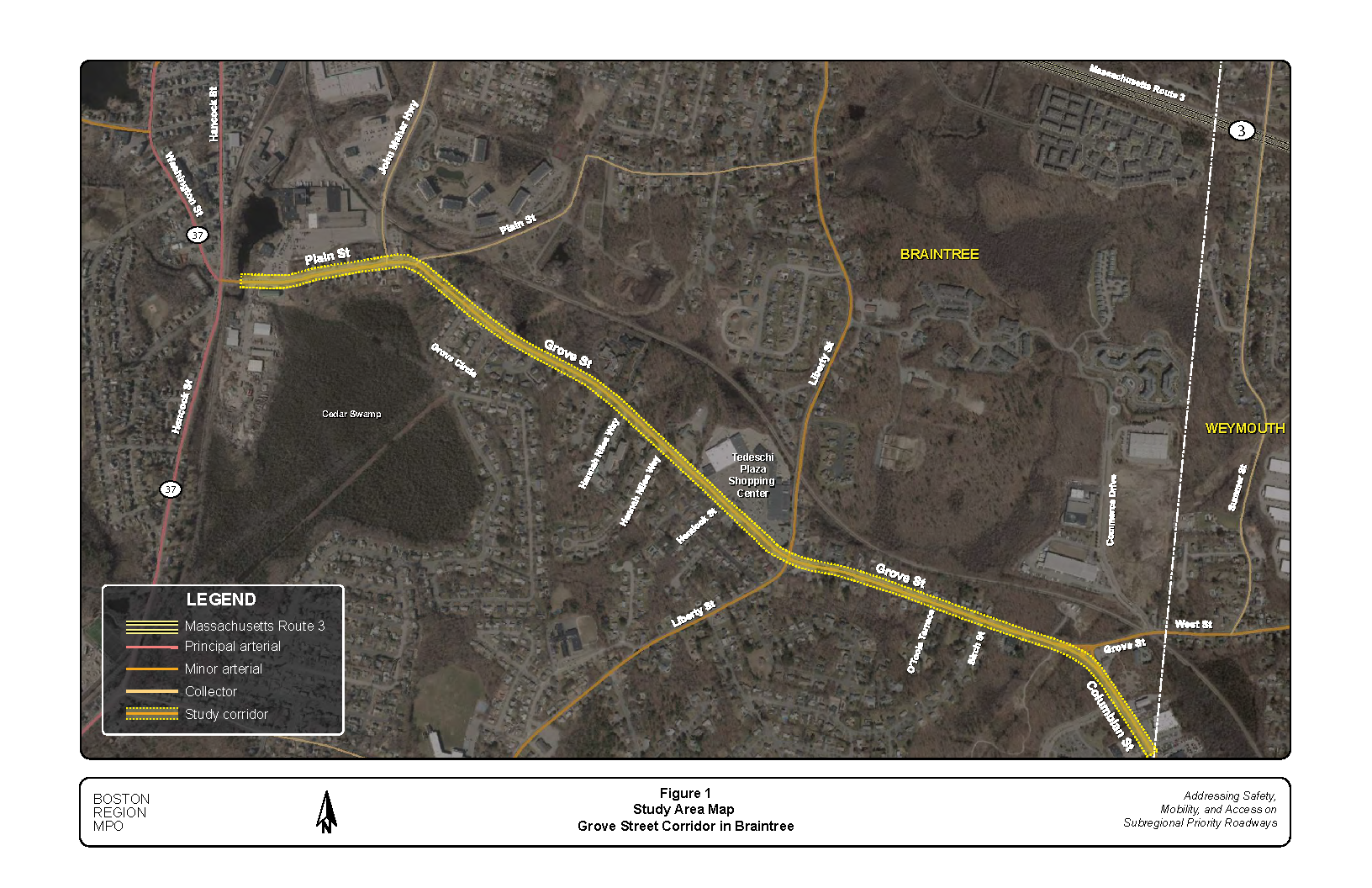
Figure 2
Transit Services in the Area
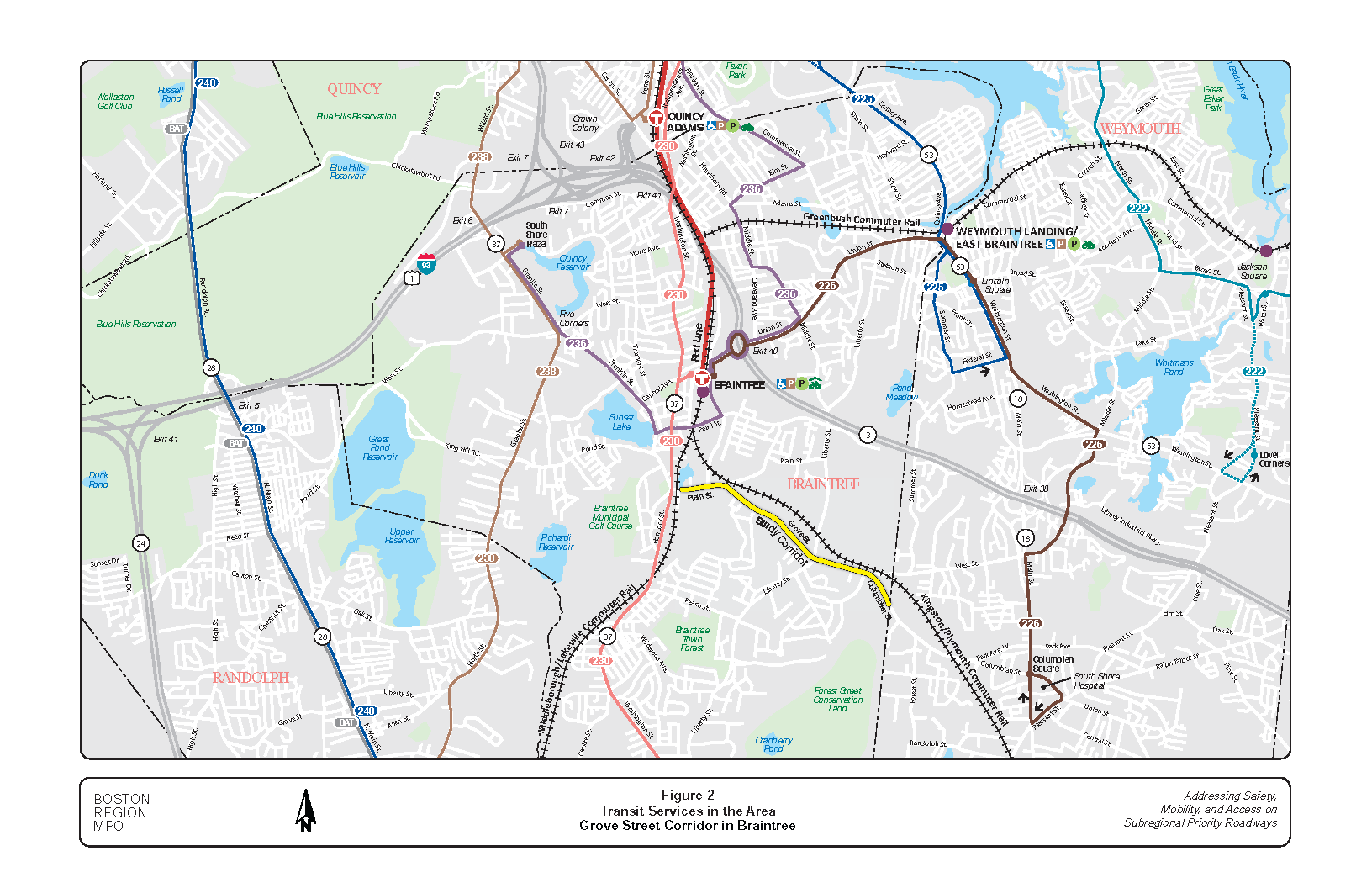
Figure 3
Corridor User Survey Questions and Results
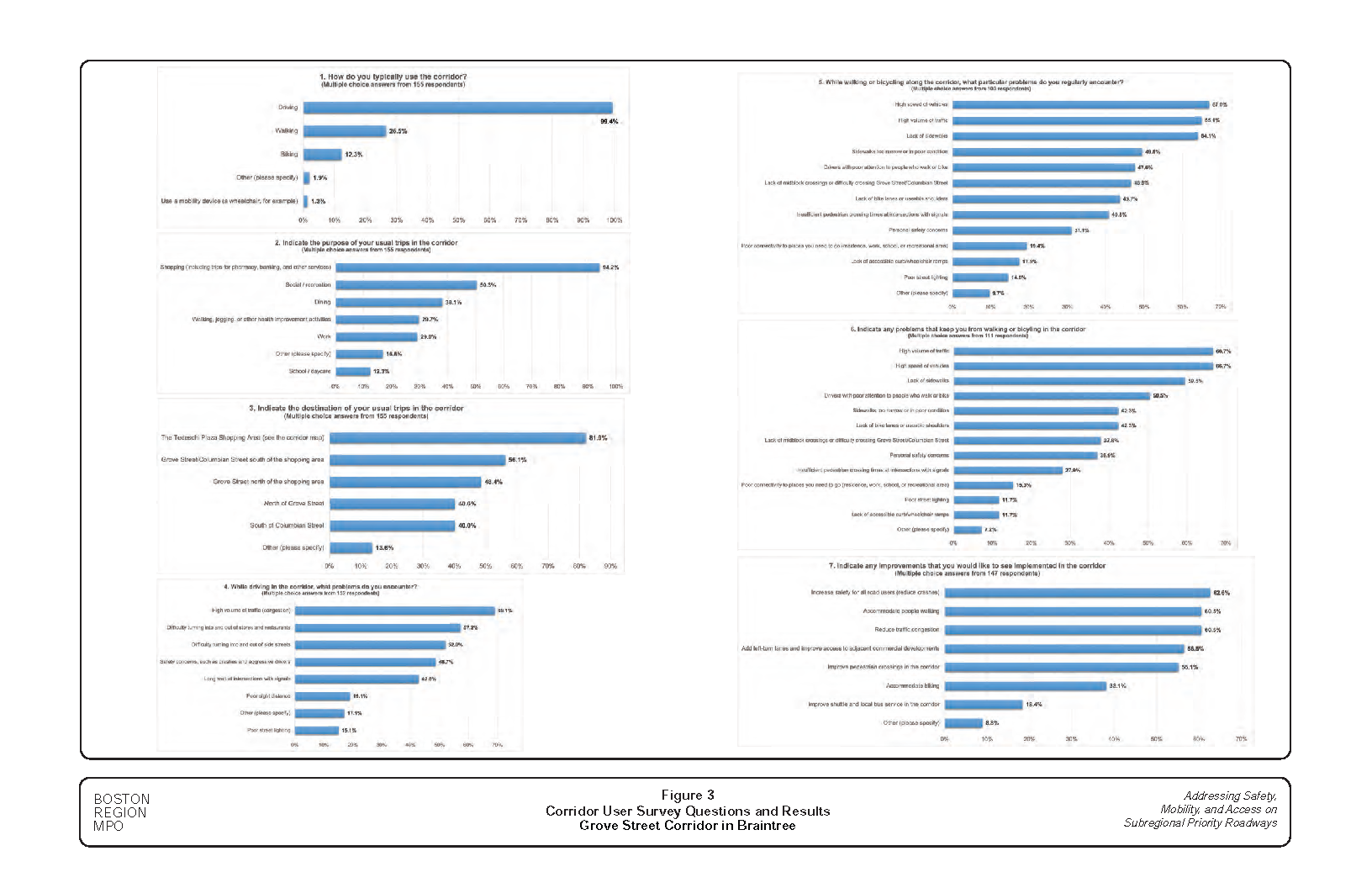
Figure 4
Average Weekday Traffic Volumes
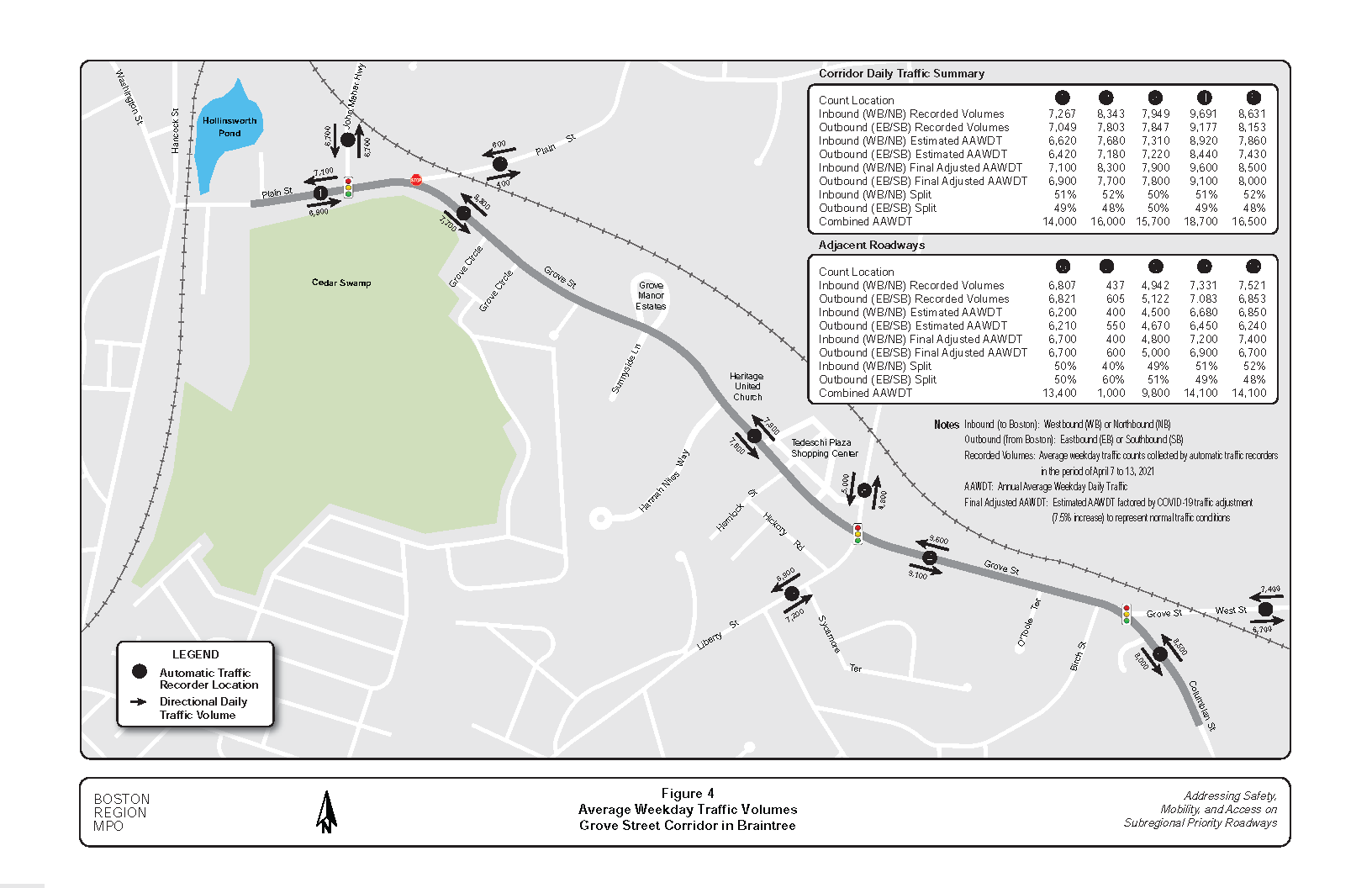
Figure 5
2021 Observed Weekday AM/PM Peak-Hour Intersection Traffic and Pedestrian Volumes
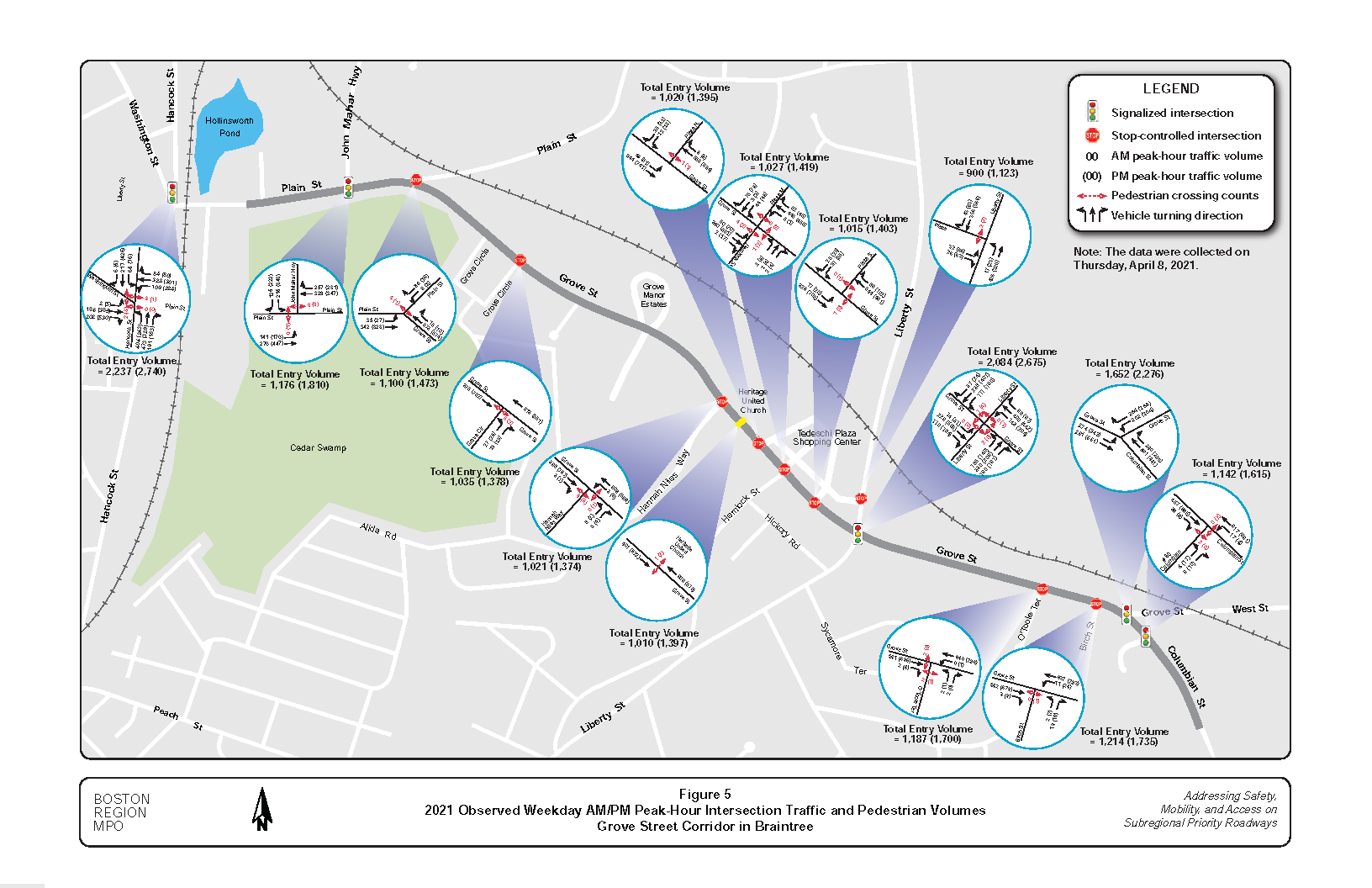
Figure 6
2021 Estimated Weekday AM/PM Peak-Hour Intersection Traffic and Pedestrian Volumes
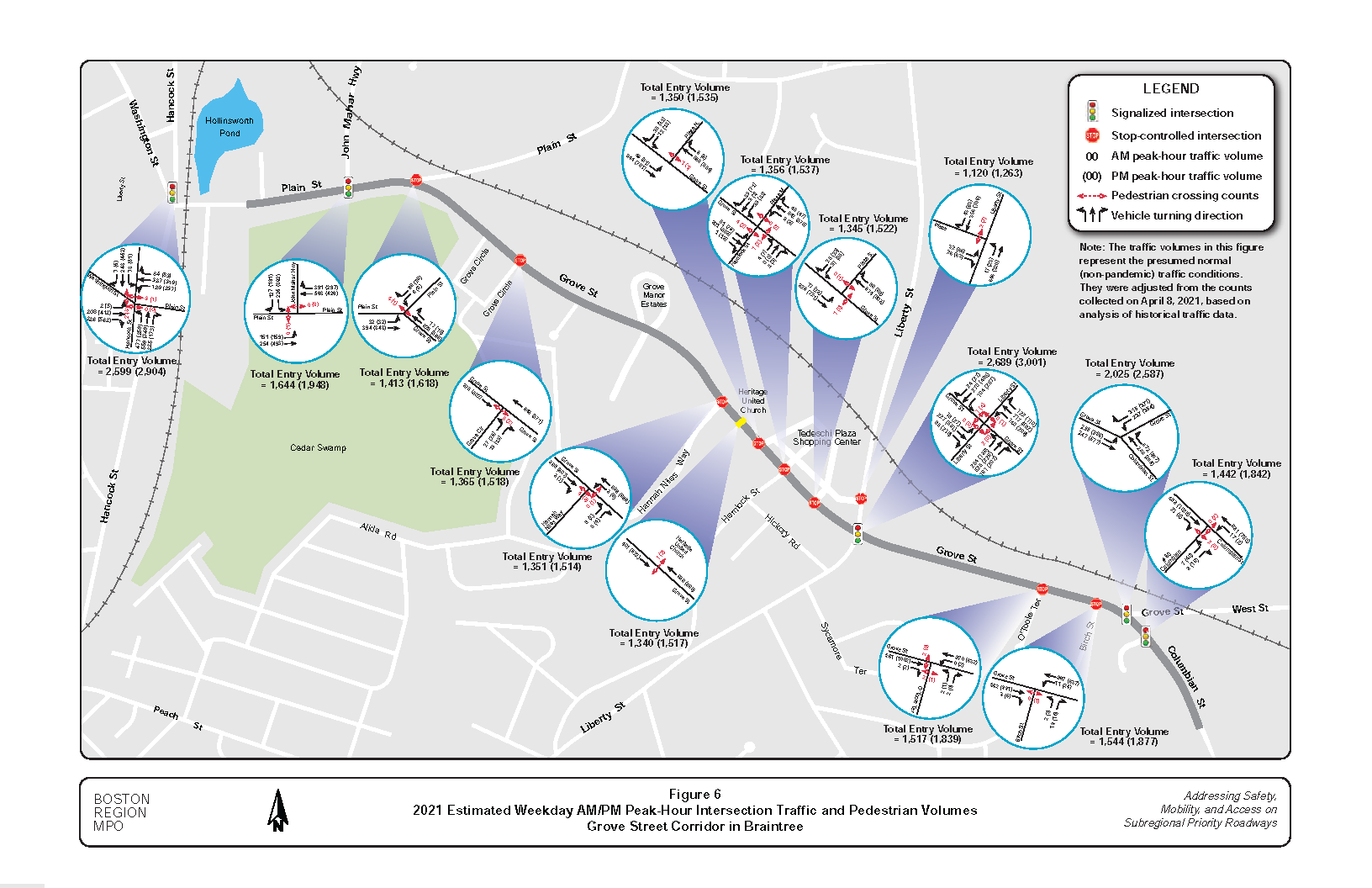
Figure 7
2021 Weekday AM/PM Peak-Hour Intersection Capacity Analysis: Observed Traffic Conditions
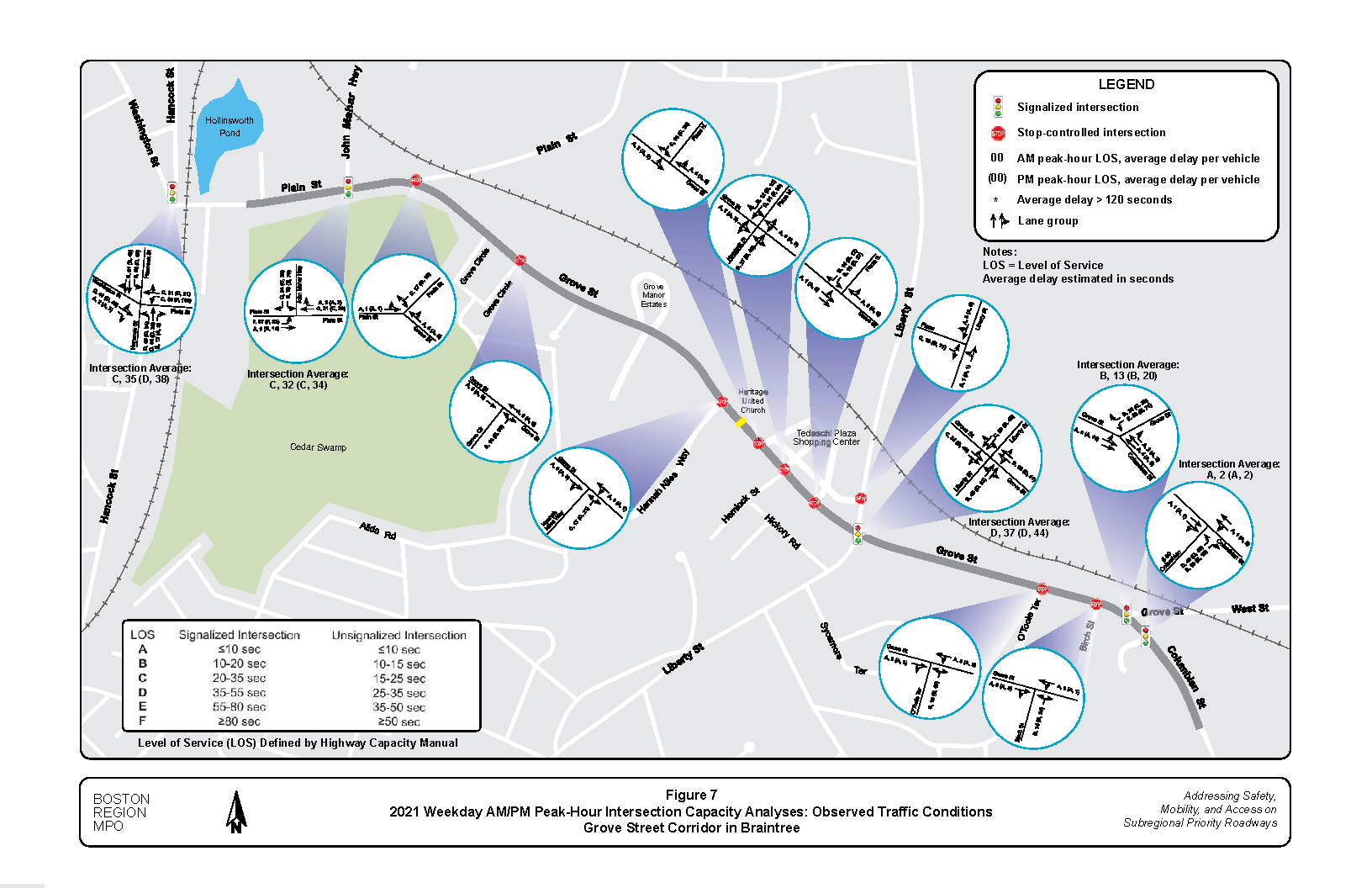
Figure 8
2021 Weekday AM/PM Peak-Hour Intersection Capacity Analysis: Estimated Traffic Conditions
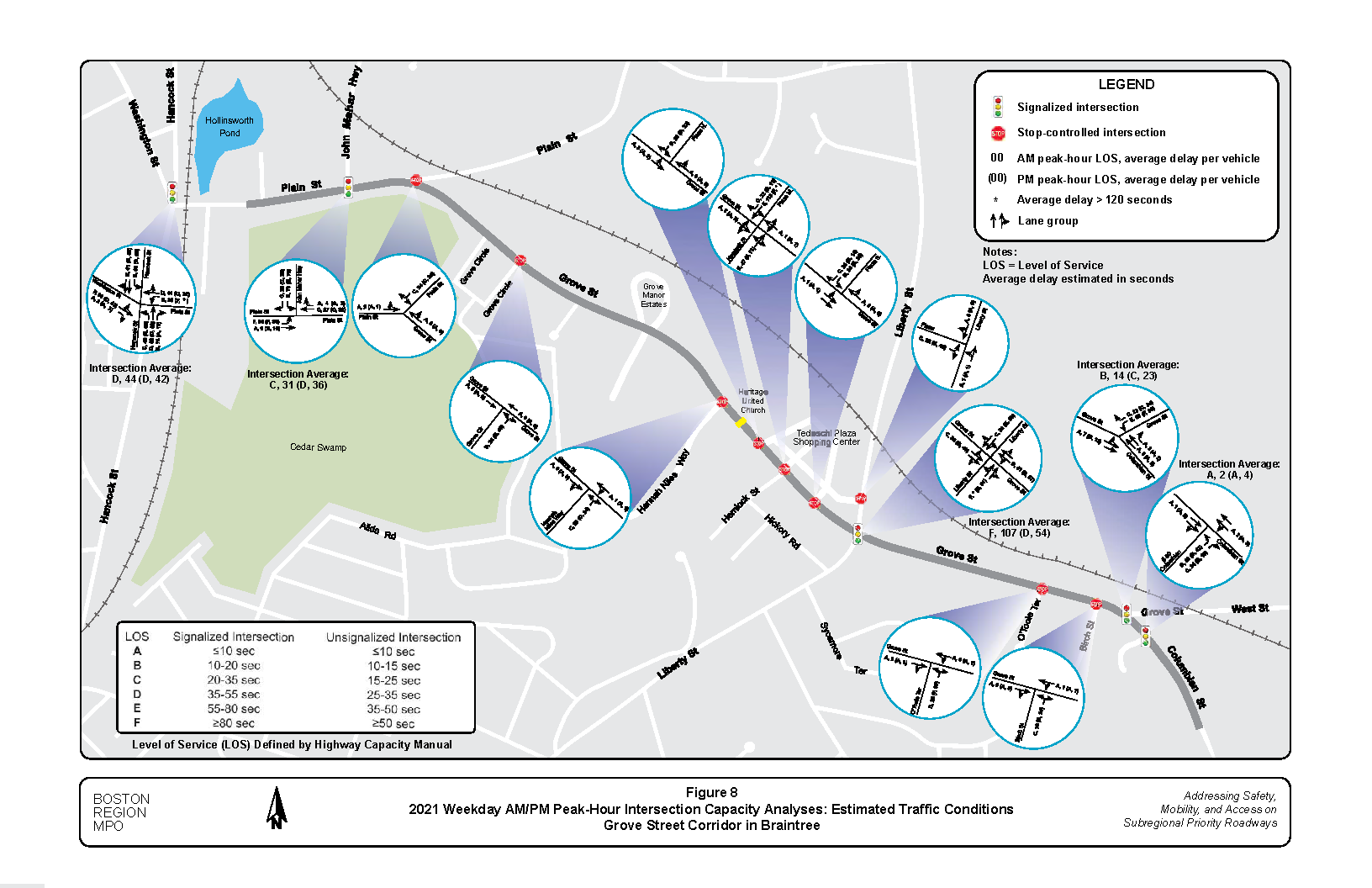
Figure 9
Speed Regulations and Estimated 85th Percentile Speeds
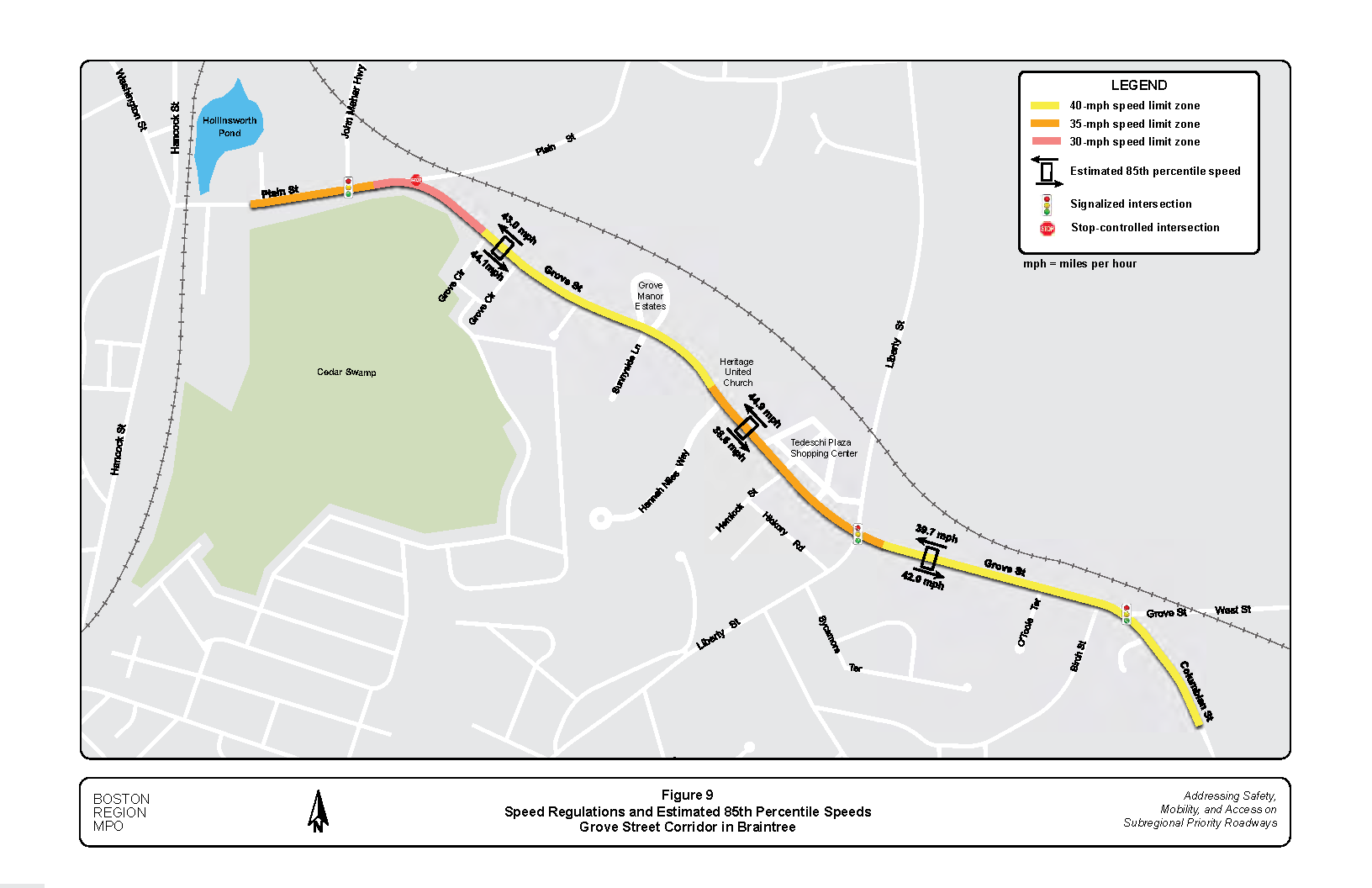
Figure 10
Existing Roadway Cross Section and Potential Reconfigurations: Plain Street between Hancock Street and Grove Street
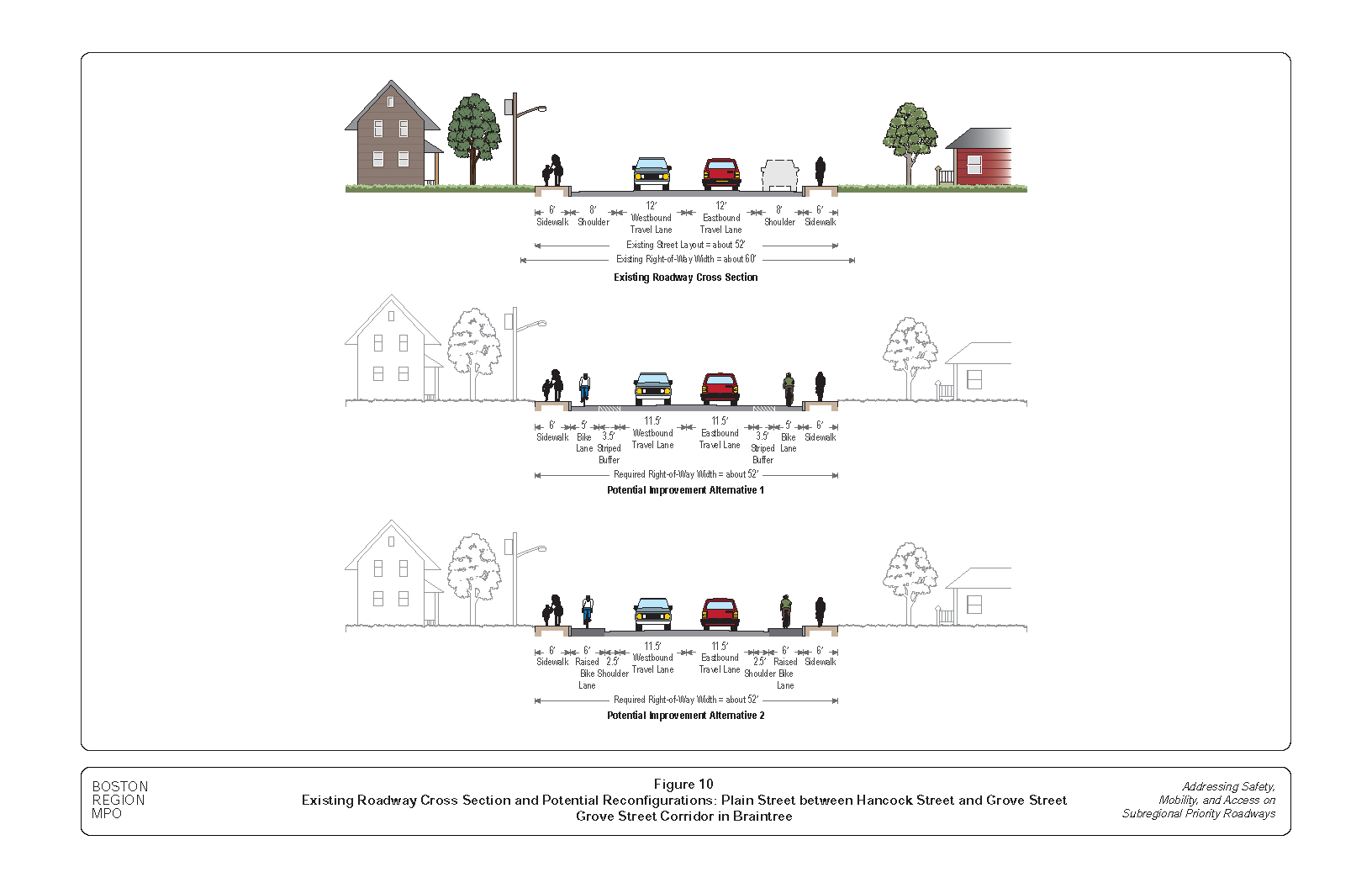
Figure 11
Existing Roadway Cross Section and Potential Reconfigurations: Grove Street between Plain Street and Liberty Street
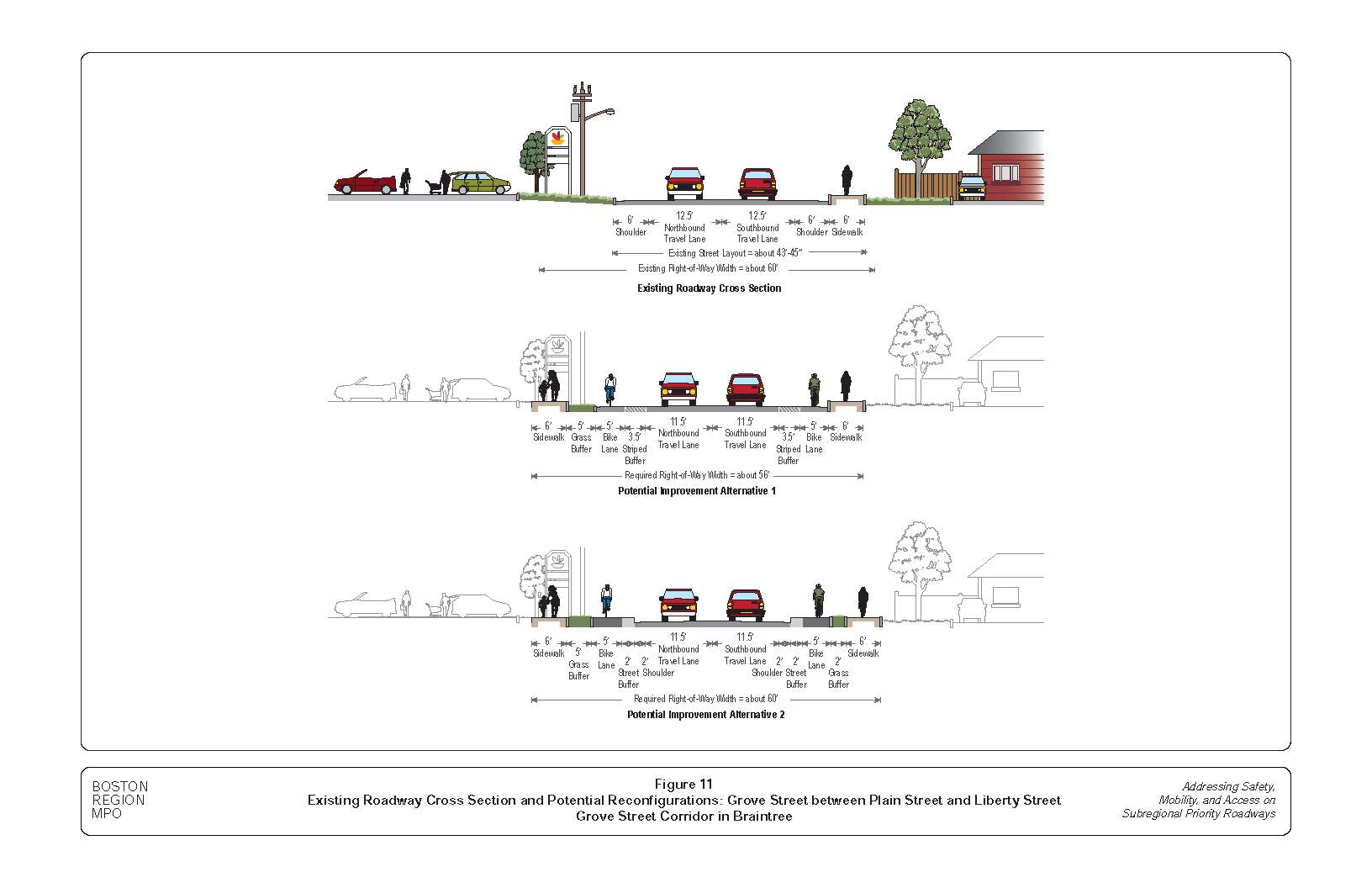
Figure 12
Existing Roadway Cross Section and Potential Reconfigurations: Grove Street between Liberty Street and Columbian Street
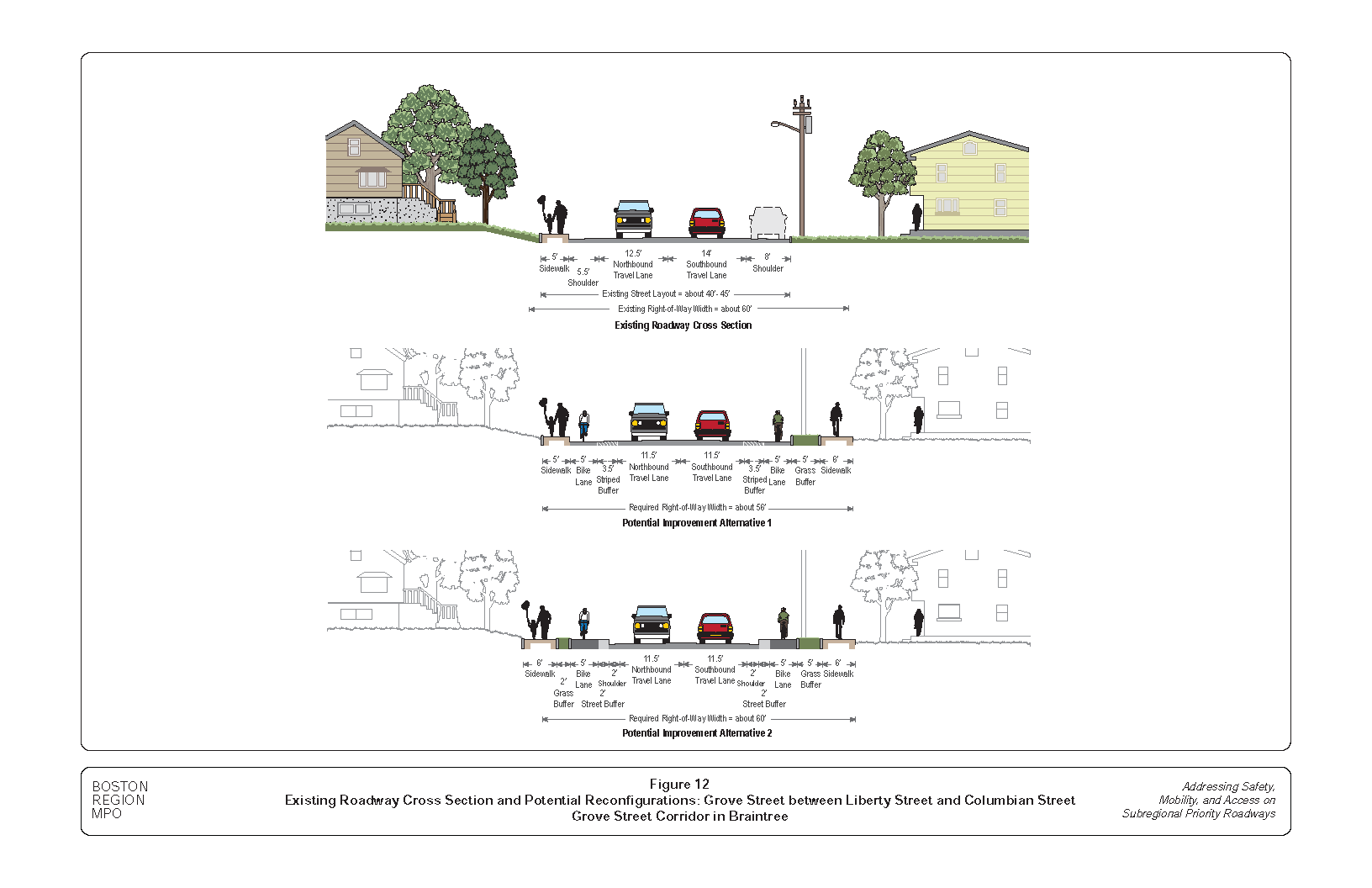
Figure 13
Existing Roadway Cross Section and Potential Reconfigurations: Columbian Street between Grove Street and Weymouth Town Line
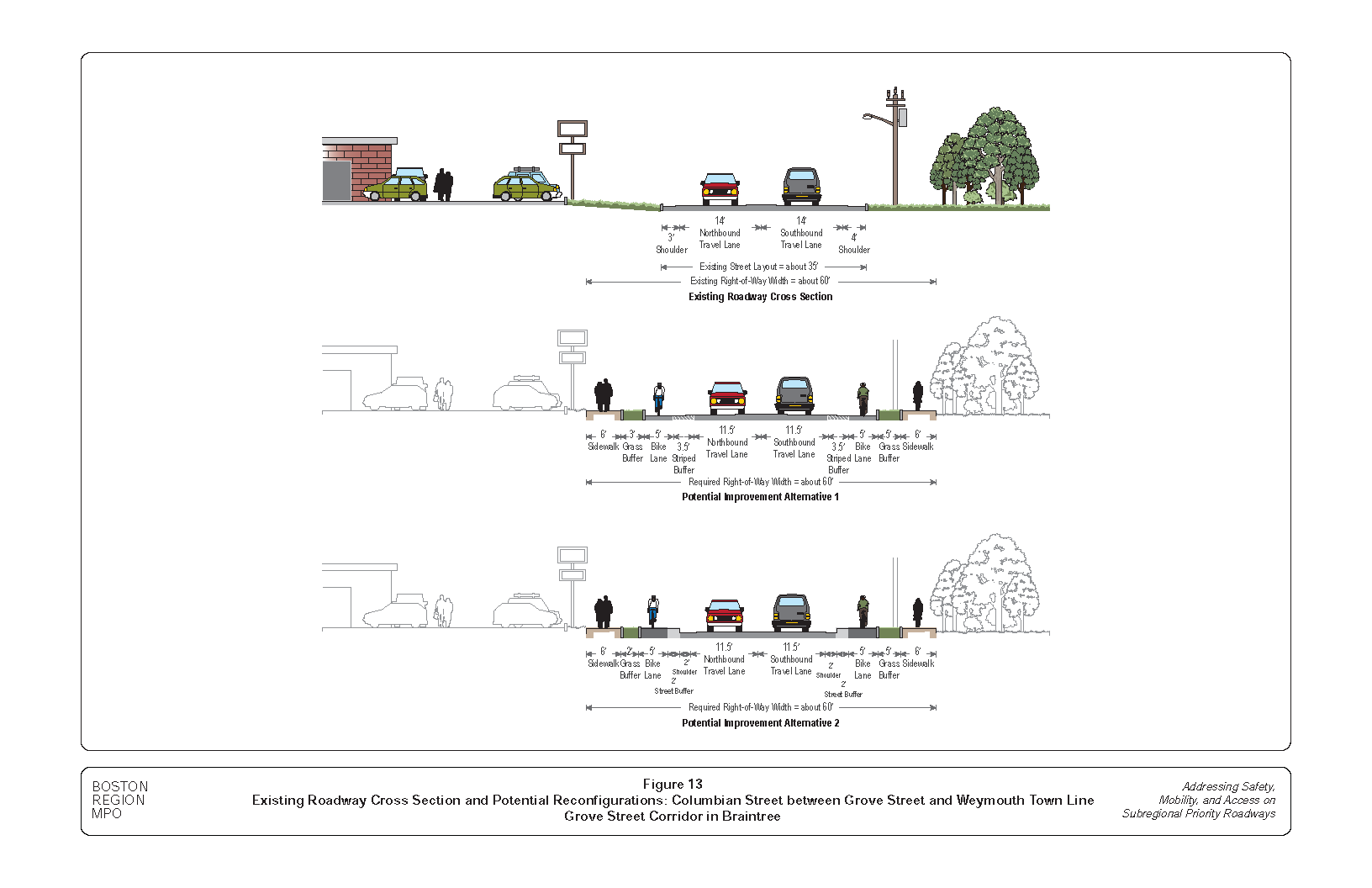
Figure 14
Proposed Improvements Conceptual Plan: Plain Street between Hancock Street and Grove Street
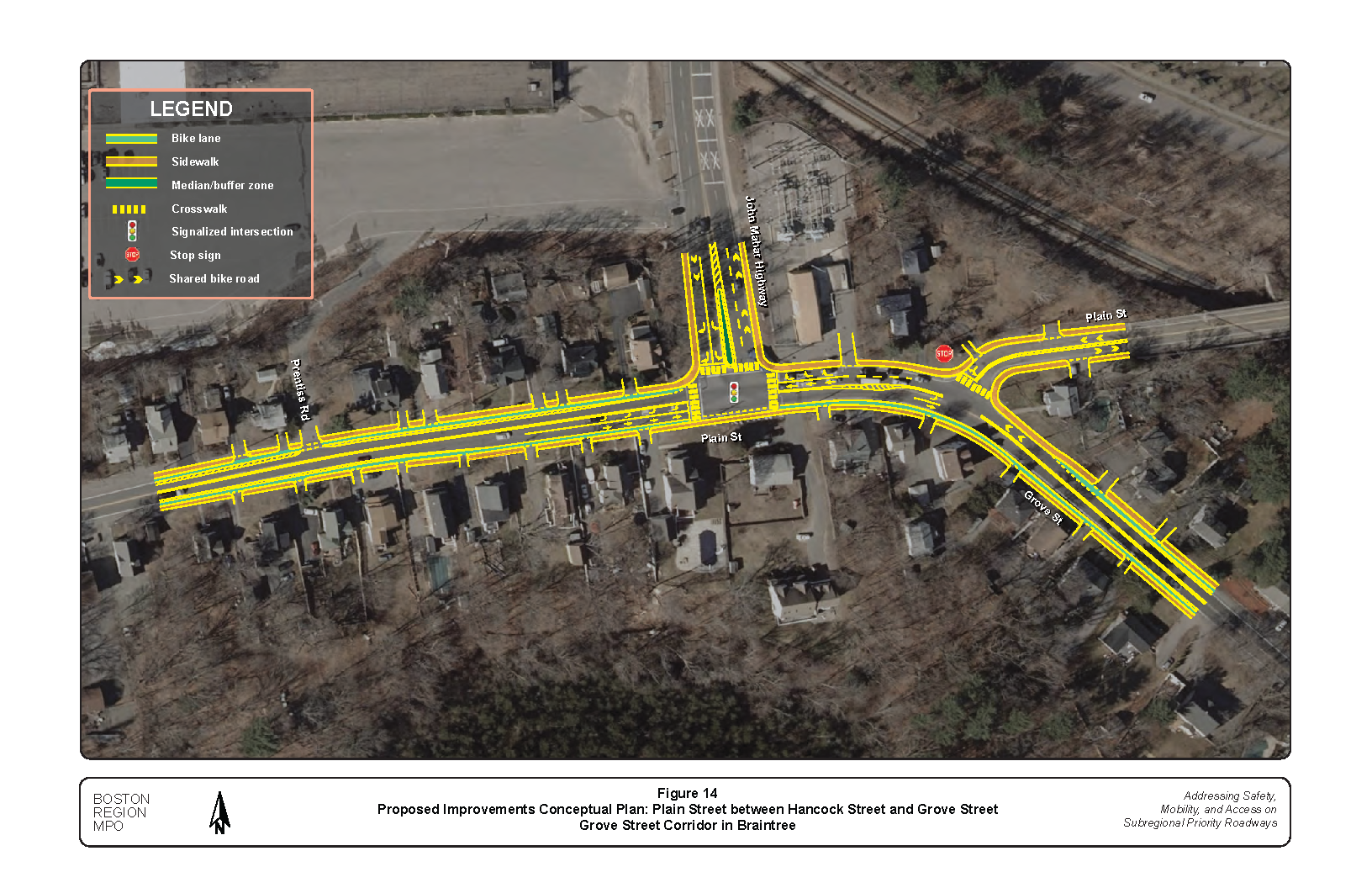
Figure 15
Proposed Improvements Conceptual Plan: Grove Street between Plain Street and Liberty Street (Section 1)
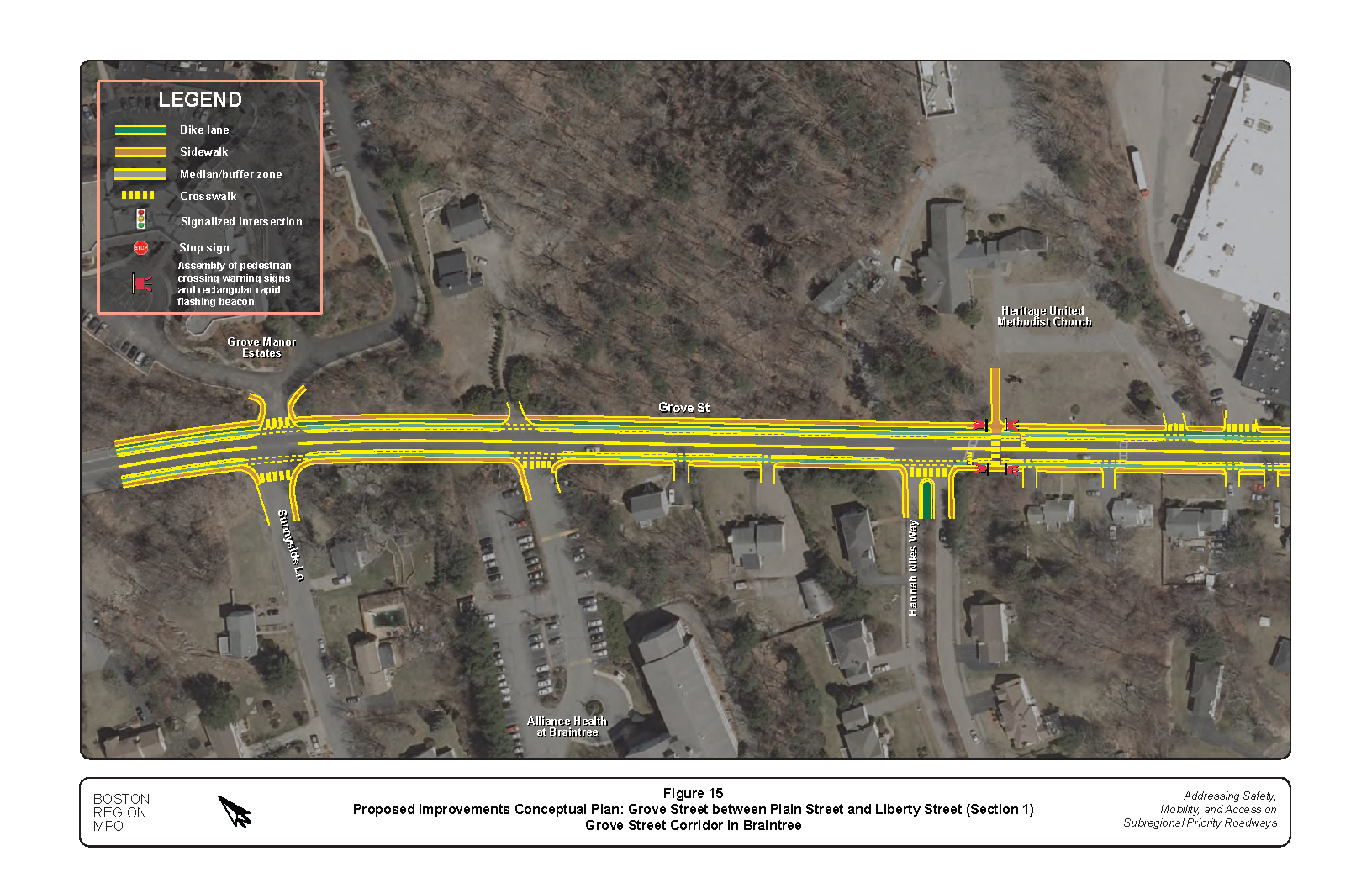
Figure 16
Proposed Improvements Conceptual Plan: Grove Street between Plain Street and Liberty Street (Section 2)
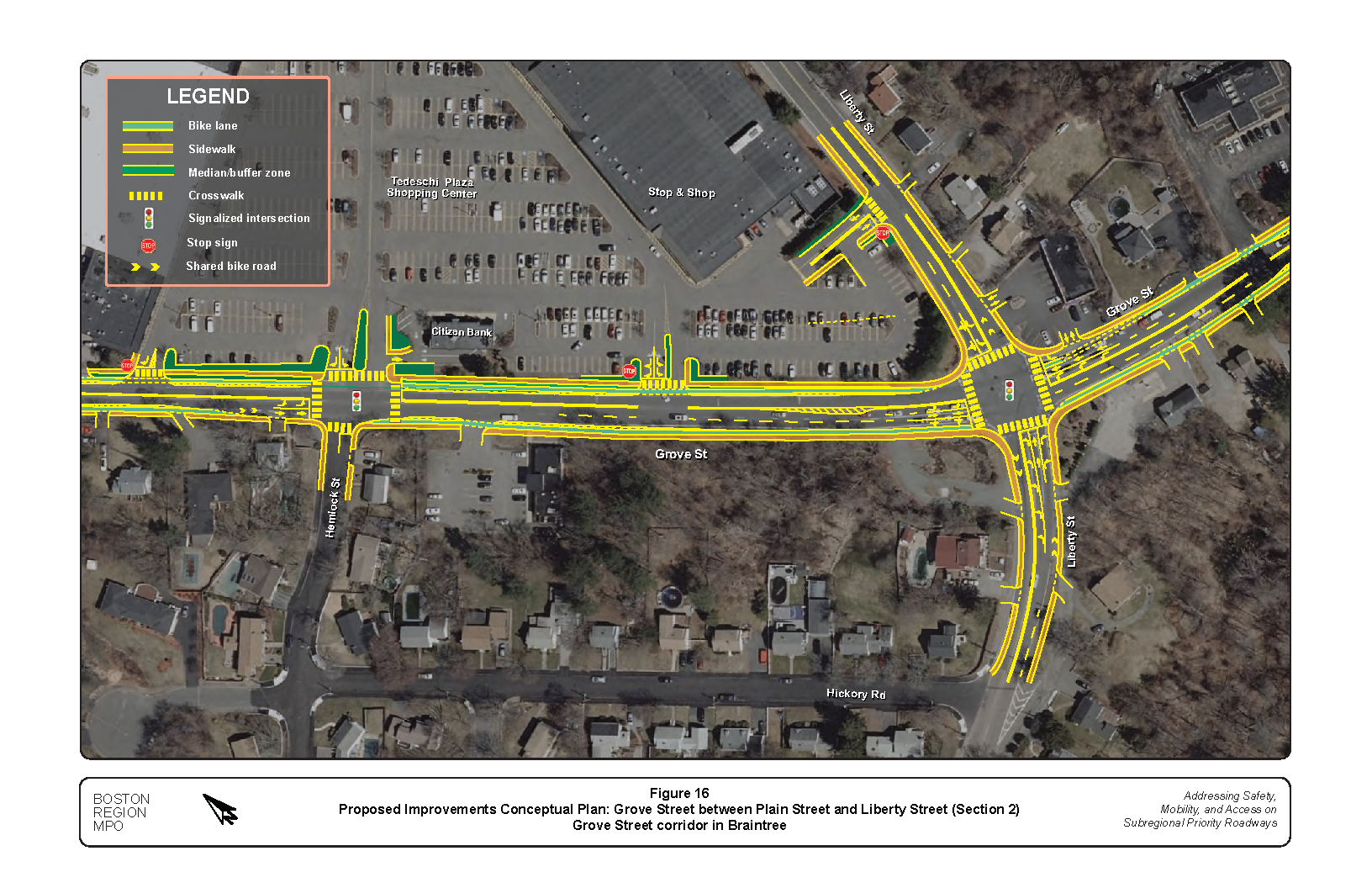
Figure 17
Proposed Improvements Conceptual Plan: Grove Street between Liberty Street and Columbian Street
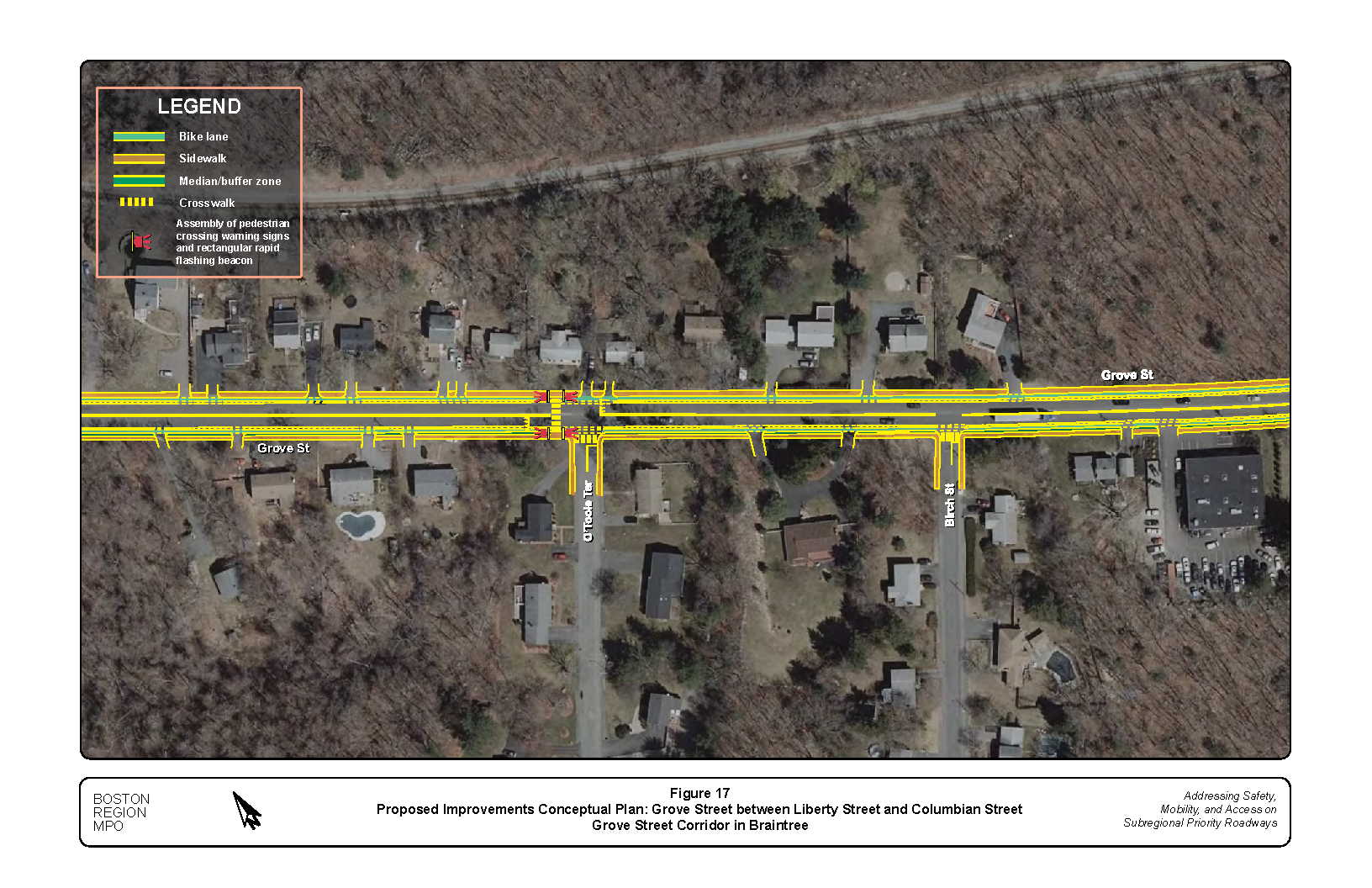
Figure 18
Proposed Improvements Conceptual Plan: Columbian Street between Grove Street and Weymouth Town Line
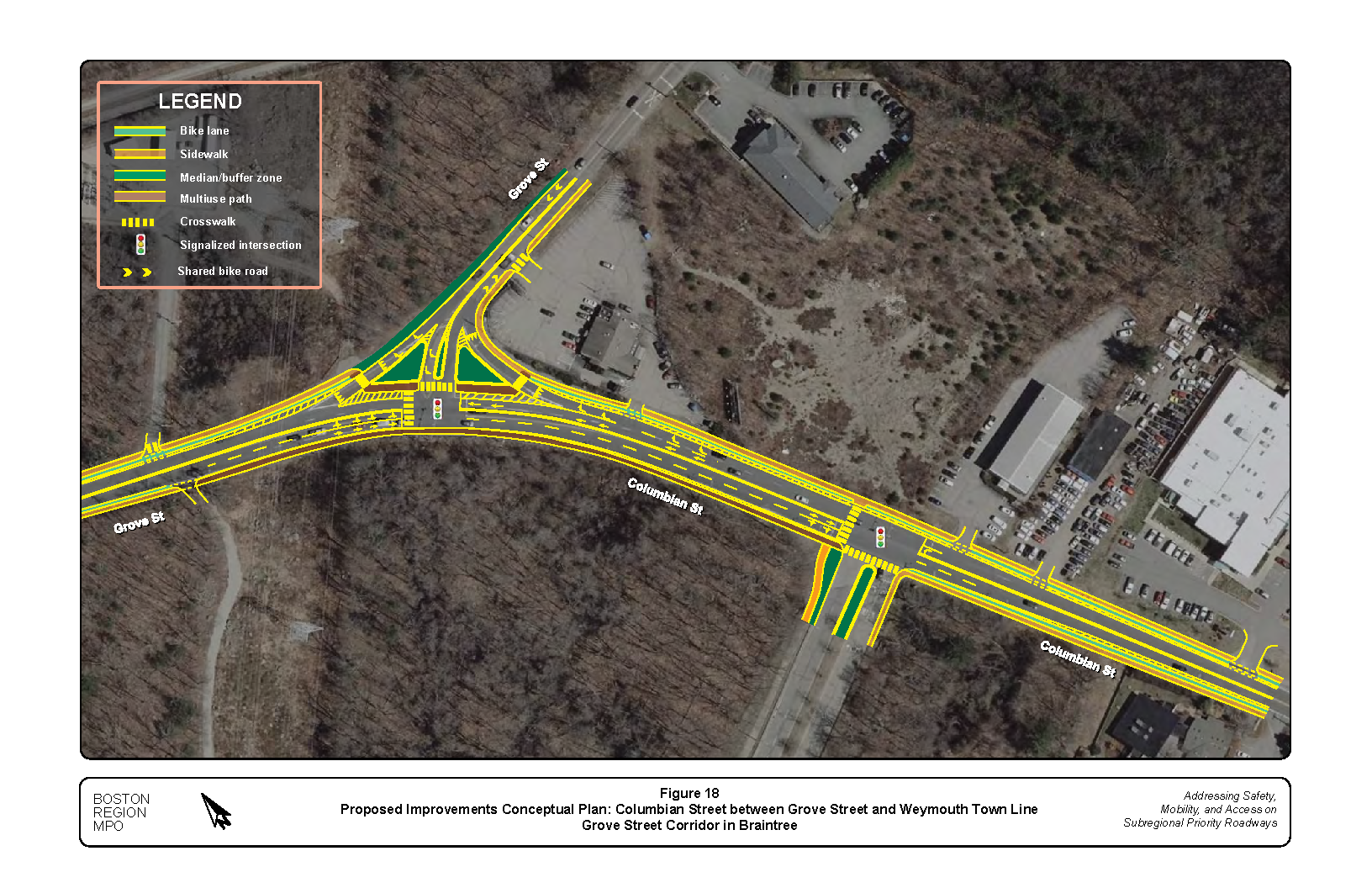
Figure 19
2030 Weekday AM/PM Peak Hour Intersection Capacity Analyses: Projected Traffic Conditions with Proposed Improvements
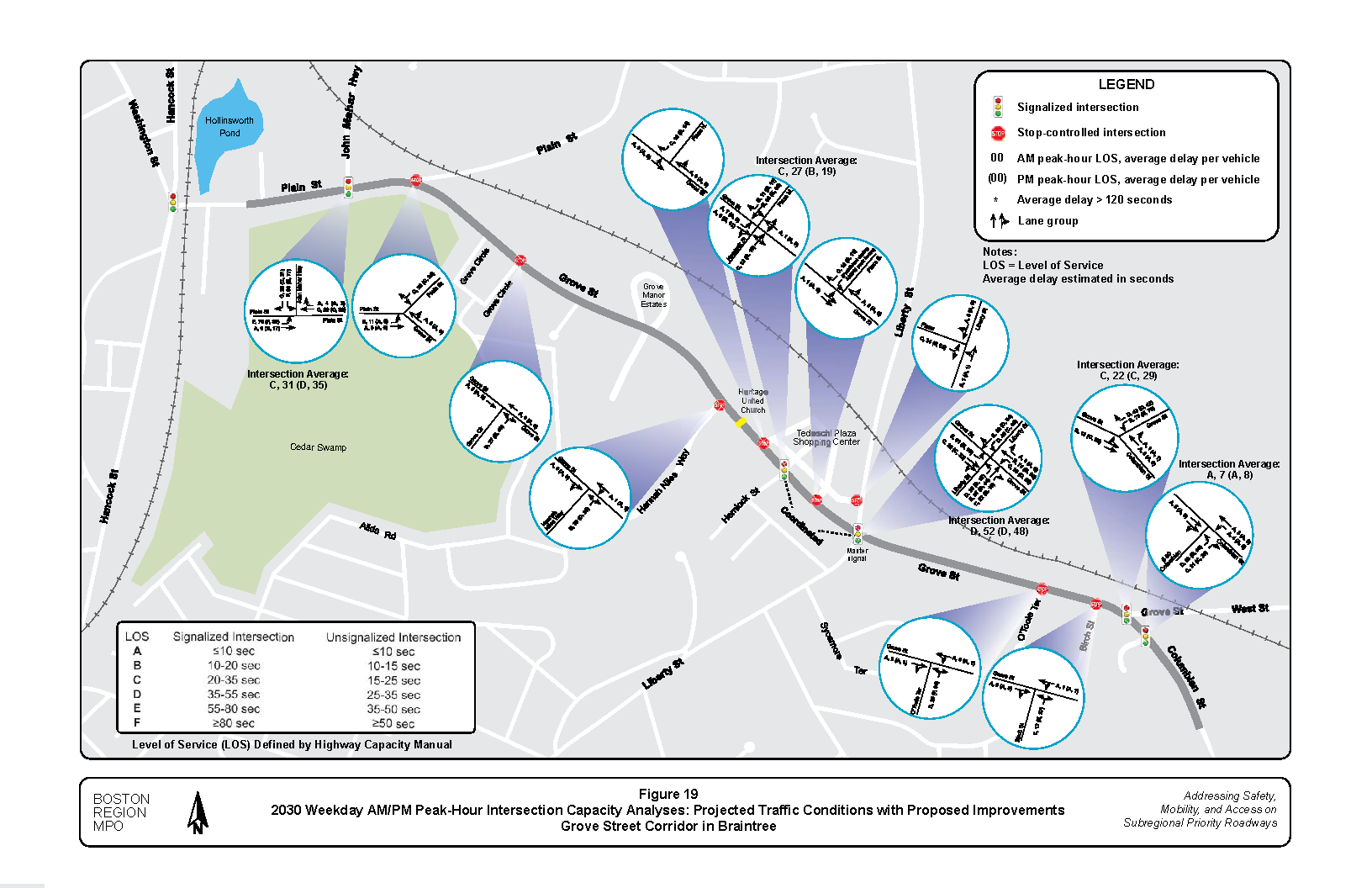
1 Roadways prioritized for improvement through this needs assessment are addressed through another annual work program, Addressing Priority Corridors from the Long-Range Transportation Plan Needs Assessment.
2 Details of the criteria and rating system may be found in the Central Transportation Planning Staff’s technical memorandum, “Selection of FFY 2021 Subregional Priority Roadway Study Location,” dated December 17, 2020.
3 In this study, the term “pedestrian crashes” refers to crashes that involve at least one vehicle and one pedestrian; “bicycle crashes” refers to crashes that involve at least one vehicle and one bicycle. No crashes between at least one bicycle and one pedestrian were identified in the data.
4 The intersection does not provide dedicated travel lanes and signal phases for left turns at all approaches, and it has a high proportion of left turns, especially on the Liberty Street northbound.
5 The southbound approach does not have an exclusive left-turn lane and operates under a lagging protected left-turn signal phase. Meanwhile, left-turn vehicles on the approach have to cross two northbound travel lanes, with limited sight distances under heavy traffic.
6 Governor Baker's COVID-19 Order #5, which prohibited gatherings of more than 25 people, was issued on March 15, 2021.
7 Since April 2020, MassDOT continually monitored the impacts of COVID-19 on the state’s transportation network, including roadways and transit services, and published weekly traffic volumes at permanent count stations in the state, with comparison of the volumes in the same period in 2019, on the MassDOT Mobility Dashboard (https://mobility-massdot.hub.arcgis.com).
8 The historical data include two main resources: (1) available traffic counts in and around the study area from MassDOT Transportation Data Management System (Massachusetts government webpage https://www.mass.gov/traffic-volume-and-classification) and (2) traffic impact study conducted in 2019 for the redevelopment of 60 Columbian Street in Braintree.
9 The peak hour alternation mainly refers to the Grove Street and Columbian Street sections of the corridor. There were no sufficient historical data to compare the counts in the Plain Street section of the corridor.
10 Transportation Impact Assessment: 60 Columbian Street, Braintree, Massachusetts, Prepared for Brigham and Women’s Physicians Organization by VHB (Vanasse Hangen Brustlin) Incorporated, May 13, 2019. The study adjusted the original counts (five percent increase for the AM peak hour and four percent increase for the PM peak hour) to represent the busy traffic scenario.
11 The data from MassDOT Mobility Dashboard indicate that pedestrian and bicycle activities generally did not decrease, and they even increased somewhat in some urban areas during the pandemic. Therefore, the pedestrian and bicycle counts in this study were not adjusted and the same numbers of pedestrian crossings were used in Figures 5 and 6.
12 Heavy vehicles include single-unit trucks (Federal Highway Administration [FHWA] Vehicle Classes 5 to 7), articulated trucks (single- and multi-trailer trucks, FHWA Vehicle Classes 8 to 13), and buses (FHWA Vehicle Class 4). Vehicles on a single frame with two axles and six tires (dual rear wheels) (FHWA Vehicle Class 5) include trucks and recreational vehicles. Passenger cars of any type and all other two-axle, four-tire vehicles (FHWA Vehicle Class 3), such as pickups, vans, mini-buses, ambulances, motorhomes, and trailers (even a passenger car pulling a trailer) are not considered heavy vehicles.
13 Synchro Version 10.3 was used for the analyses. This software is developed and distributed by Trafficware Ltd. It can perform capacity analyses and traffic simulation (when combined with SimTraffic) for an individual intersection or a series of intersections in a roadway network.
14 Highway Capacity Manual 2010, Transportation Research Board of the National Academies, Washington, DC.
15 Control delay quantifies the increase in travel time that a vehicle experiences due to a traffic signal or other type of control. It also provides a surrogate measure for driver discomfort and fuel consumption.
16 To establish or modify speed controls, MassDOT requires the collection of speed data by radar gun or laser gun at critical locations at intervals not to exceed 0.25 miles, in addition to vehicle trial runs in the study area.
17 This is a preliminary planning study that does not incorporate detailed design of the proposed improvements. Figures 14 to 18, the proposed improvements conceptual plans, exhibit the layout and approximate dimensions of key elements in the proposed reconfiguration Alternative 1 that contains street-level separated bike lanes for the different roadway sections in the corridor (Section 4.7). They can also be used to gauge the proposed reconfiguration Alternative 2 that contains sidewalk-level or raised bike lanes, as both alternatives have a similar layout except that Alternative 2 would require slightly more space for sidewalk buffers in a few roadway sections in the corridor.
18 Based on a quick review of the existing right-of-way from the MassGIS level-3 Parcel data, the separated bike lanes are considered feasible only on the southbound side of the roadway between John Mahar Highway and Grove Street. At the design stage, they should be further considered to be installed on both sides of the roadway, with more precise land surveys and other opportunities such as minor land takings. Meanwhile, a bike box can be considered on the southbound approach for left turns from Plain Street to John Mahar Highway, if the left-turn demand justifies the installation.
19 This study corridor, John Mahar Highway, and Ivory Street, form a major route for South Shore commuters and residents to reach Braintree Station; safe and convenient accommodation for people who bike along this route is highly desirable. The further study could examine the potential of converting the existing four-lane roadway to a two- to three-lane roadway with separated bike lanes on both sides.
20 This intersection is being coordinated with the traffic signal at the rail crossing on John Mahar Highway in the north where drivers experience extensive delays during the train crossings. Further north on John Mahar Highway at Pearl Street, drivers also experience extensive delays, especially making the northbound left turns to Pearl Street. Currently, this intersection operates at acceptable level of service (LOS) under both the observed and estimated traffic conditions. In the future, this and the intersections of John Mahar Highway at the rail crossing and at Peal Street should be studied together for signal timing and coordination improvements.
21 This intersection is being coordinated with the traffic signal at the rail crossing on John Mahar Highway in the north where drivers experience extensive delays during the train crossings. Further north on John Mahar Highway at Pearl Street, drivers also experience extensive delays, especially making the northbound left turns to Pearl Street. Currently, this intersection operates at acceptable LOS under both the observed and estimated traffic conditions. In the future, this and the intersections of John Mahar Highway at the rail crossing and at Peal Street should be studied together for signal timing and coordination improvements.
22 As the roadway is relatively wide, the crosswalks would be more conspicuous to drivers if the pedestrian crossing warning signs are installed on both sides in both directions. Currently they exist only on one side in each direction and the warning sign at the crosswalk near the church is absent in the southbound direction. Meanwhile, the warning sign on the northbound side at the crosswalk near Hannah Niles Way is obscured by a utility pole and overgrown vegetation.
23 Currently the two crosswalks have a low use rate of about one crossing per hour during the day time. The north side of the crosswalk near Hannah Niles Way has a limited landing area with overgrown vegetation. The crosswalk near the church is located away from the main walkway leading to the church. Meanwhile, people may cross the roadway at locations other than the two crosswalks. Combining them into one crosswalk located near the church’s main walkway with the RRFB’s reinforcement of drivers’ attention to pedestrian crossing activities would encourage people to use the crosswalk and significantly improve their safety.
24 According to Federal Highway Administration (FHWA) Manual on Uniform Traffic Control Devices (MUTCD) Interim Approval for Optional Use of Pedestrian-Actuated Rectangular Rapid-flashing Beacons at Uncontrolled Marked Crosswalks (IA-21, dated March 21, 2018), an RRFB shall only be installed to supplement a post-mounted pedestrian crossing warning sign (MUTCD W11-2) with a diagonal downward arrow plaque (MUTCD W16-7P) located at or immediately adjacent to an uncontrolled marked crosswalk.
25 The installation of RRFB at this location complies with the guidelines of FHWA Technical Report: Guide for Improving Pedestrian Safety at Uncontrolled Crossing Locations (FHWA-SA-17-072, updated July 2018).
26 The existing signal operation includes an exclusion pedestrian signal phase of 22 seconds. Two crosswalks at the intersection have a crossing distance of nearly 70 feet. The increase to 27 seconds would provide more sufficient time for people to complete their crossings at the two crosswalks (based on estimation by using MUTCD’s guideline of 3.5 feet per second walking speed).
27 The retiming would enhance pedestrian safety and improve the intersection traffic operations especially in the AM peak hour. Appendix L presents the AM and PM peak hour capacity analyses with the retiming plans under the estimated 2021 normal traffic conditions.
28 With the reductions of travel lanes to 11 to 11.5 feet wide and turning radii, the proposed intersection layout is feasible under the existing right-of-way without increasing the pedestrian crossing distance.
29 The proposed layout was selected from a number of reconfiguration alternatives tested with projected 2030 AM and PM peak-hour traffic conditions. Appendix M contains detailed intersection capacity analyses for this proposed alternative, including the estimated average traffic queue on all the travel lanes.
30 At the design stage, the bike lane on Grove Street southbound should be further refined so as to reduce conflicts between people biking continuing straight and southbound right-turn traffic.
31 The proposed improvements at the three driveways should be regarded as a complete set for the entire section set, which should be designed and implemented together. Particularly, those proposed for the north and south driveways could be implemented only after the improvements at the middle driveway are completed.
32 Staff conducted a quick review of the intersection’s traffic signal needs based on the available automatic traffic recorder and turning movement counts data collected on April 8, 2021, with no adjustments. The analysis indicated that a traffic signal could be considered at this location, as the counts satisfied the MUTCD Traffic Control Signal Warrant 1 (eight-hour vehicular volumes) and Warrant 2 (four-hour vehicular volumes).
33 The crosswalk was installed a few years ago. It is well equipped with the pedestrian crossing warning sign (MUTCD W11-2) and a diagonal downward arrow plaque (MUTCD W16-7P) on both sides in both directions of the roadway. Due to the high vehicle travel speeds of more than 40 mph, a RRFB is not considered suitable unless the roadway is redesigned with a 35 mph speed limit or lower.
34 Birch Street situates diagonally between Grove Street and Liberty Street. It is possible that a major portion of left turns from Grove Street to Birch Street (and right turns from Birch Street to Grove Street) is cut-through traffic intending to avoid the congested intersection of Grove Street and Liberty Street during peak hours.
35 According to the guidelines of the FHWA technical report (FHWA-SA-17-072), RRFB is not suitable for roadways with a posted speed limit of 40 mph or higher. A Pedestrian Hybrid Beacon (PHB) can be considered for such roadways if it meets the installation guidelines—based on speed, pedestrian volume, vehicular volume, and crossing length—as provided in Section 4F.01 of the MUTCD. At this location, the installation of PHB does not meet the minimum requirement of 20 pedestrian crossings per hour. Therefore, staff recommend adding RRFB at this location as a long-term improvement measure after the roadway’s posted speed limit is changed to 35 mph.
36 Based on the counts collected for this intersection on April 8 and 10, 2021, there were approximately 10 to 15 left turns per hour (approximately 20 to 30 in the PM or Saturday peak hour) to and from Birch Street. These volumes do not support the installation of a separated left turn either on Grove Street or on Birch Street. Meanwhile, pedestrian crossing improvement measures such as PHB and RRFB do not meet the installation guidelines by MUTCD and FHWA Technical Report (FHWA-SA-17-072). As such, staff proposed no improvements at the moment but recommend monitoring traffic condition, especially when traffic returns to normal following the pandemic.
37 The retiming with the alteration of southbound left-turn operation would potentially reduce the crashes at the intersection (especially the southbound left-turn and rear-end collisions), while maintaining the same LOS and the coordination with the signal at the business park. Appendix L presents the AM and PM peak hour capacity analyses with the retiming plans under the estimated 2021 normal traffic conditions.